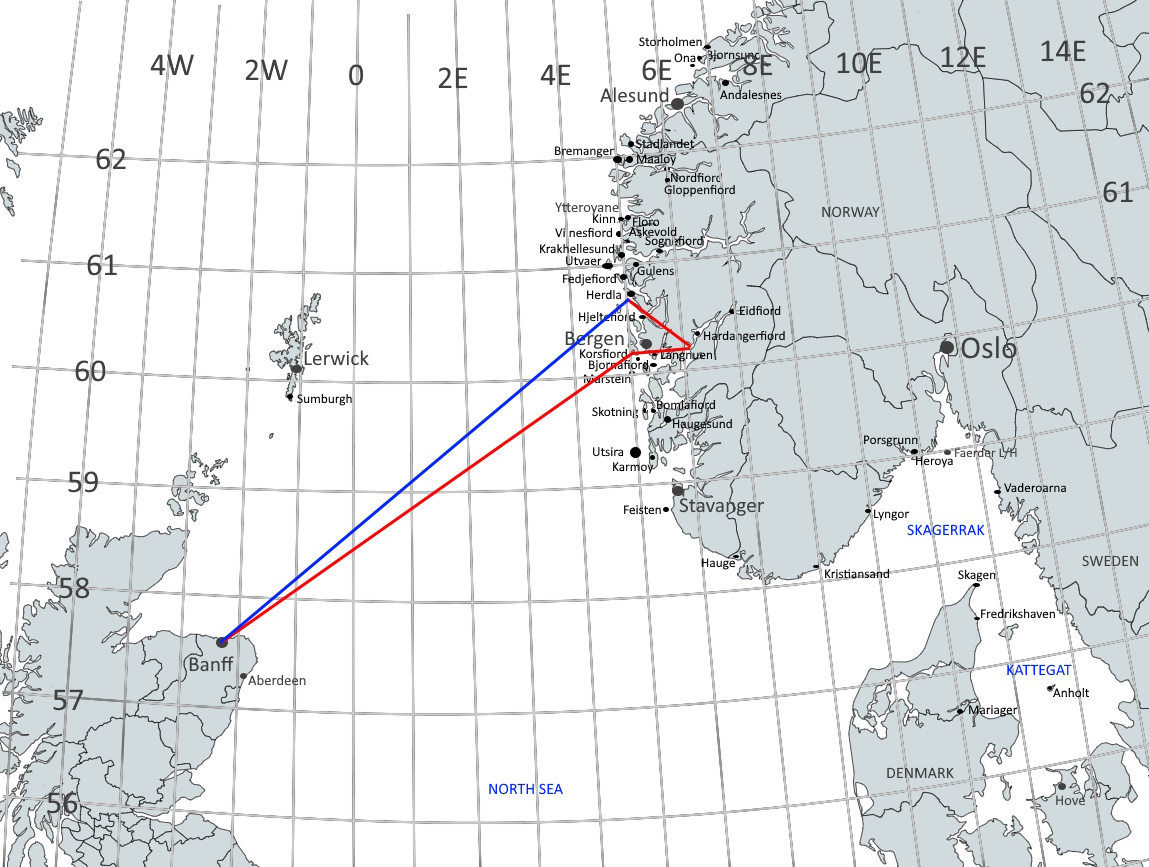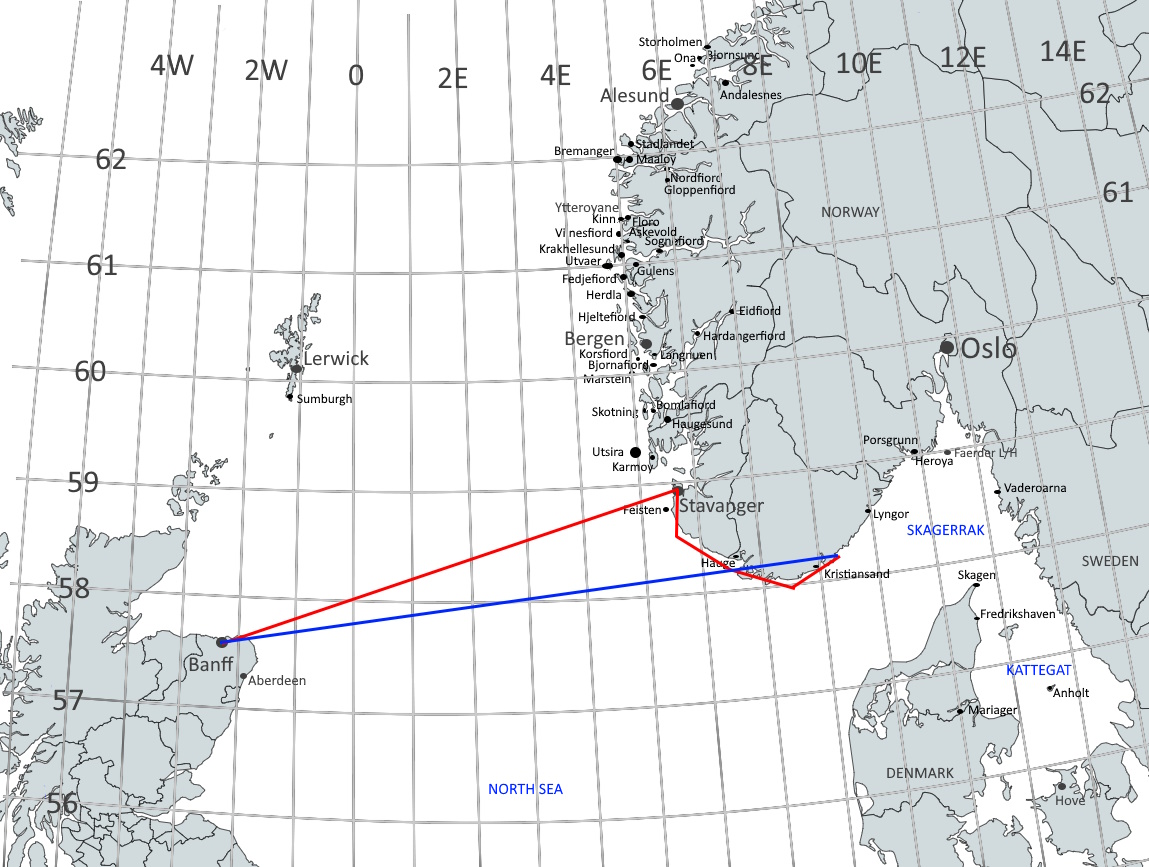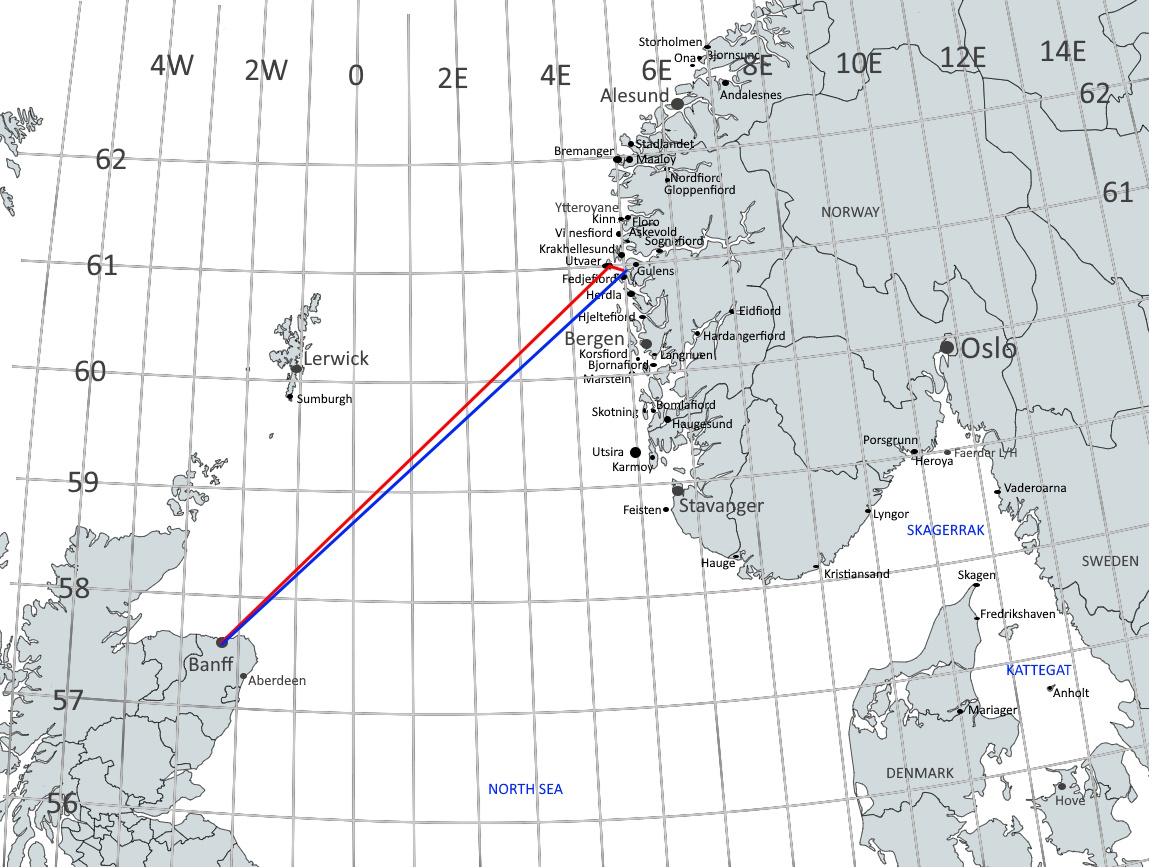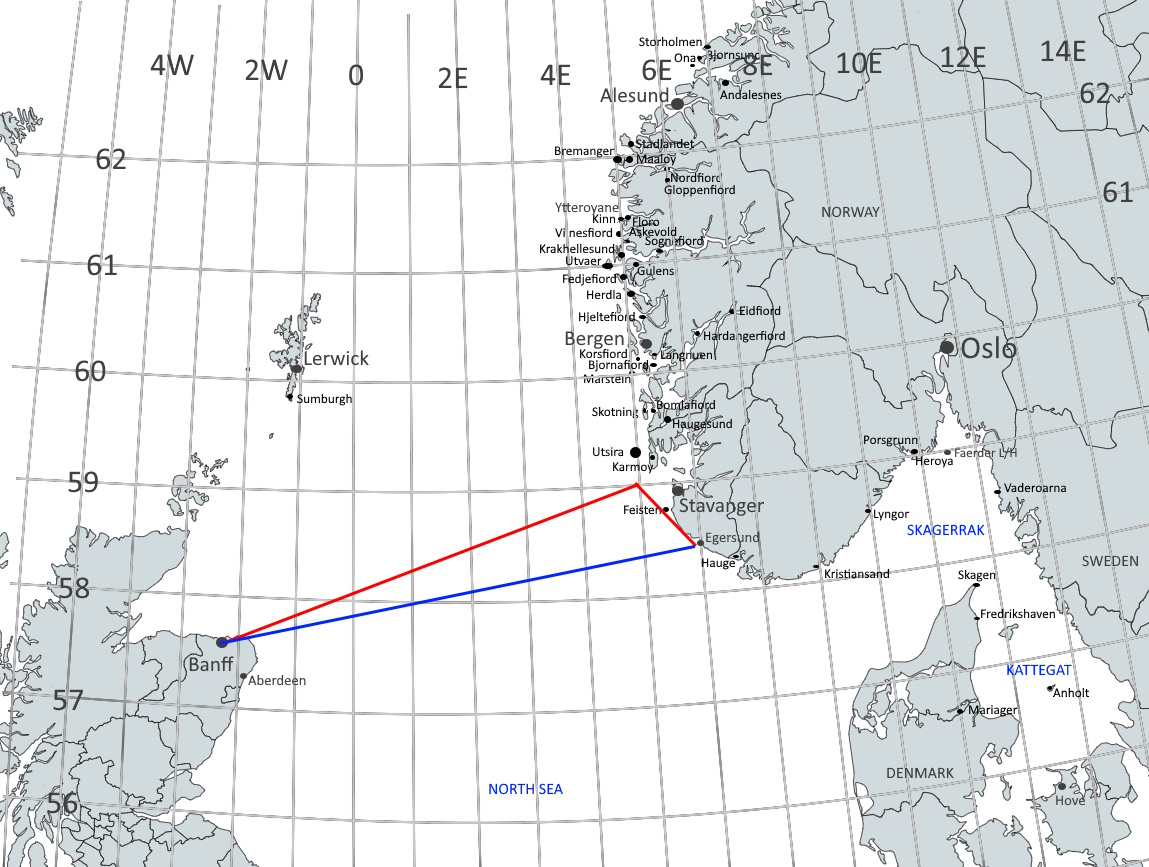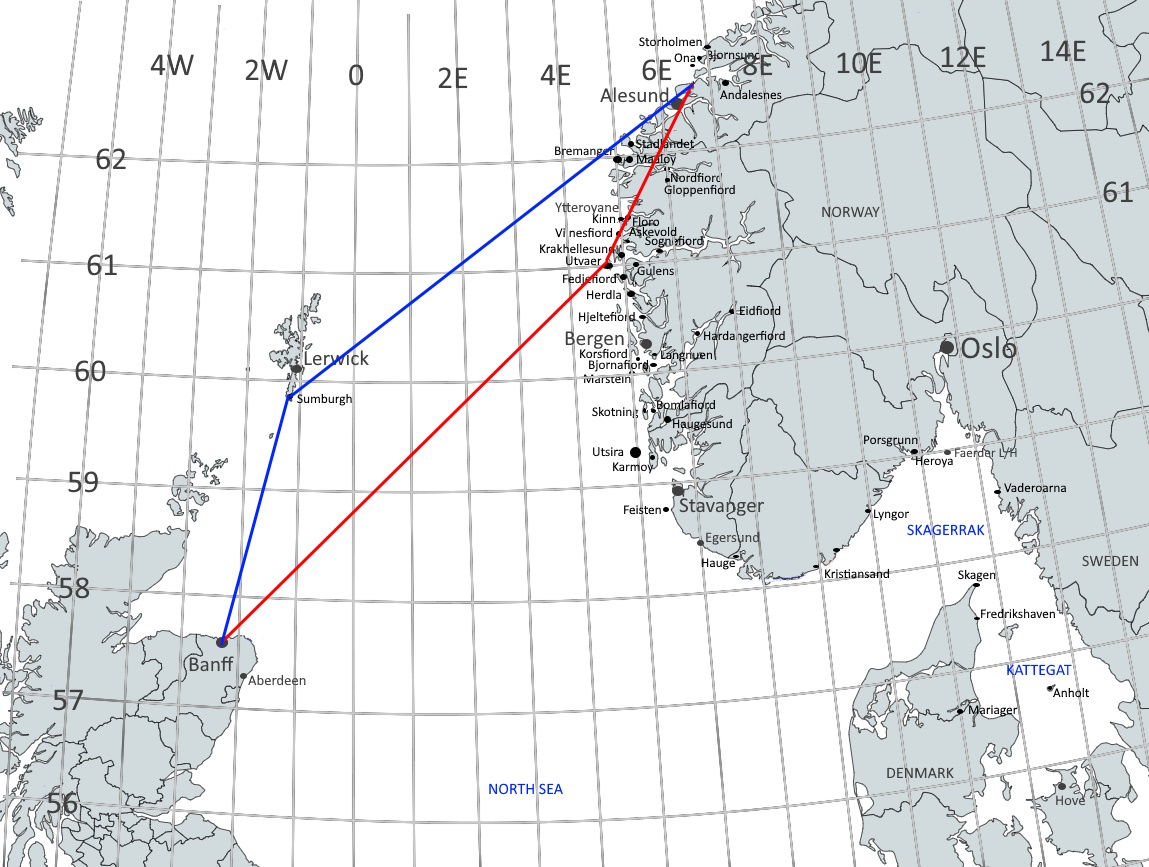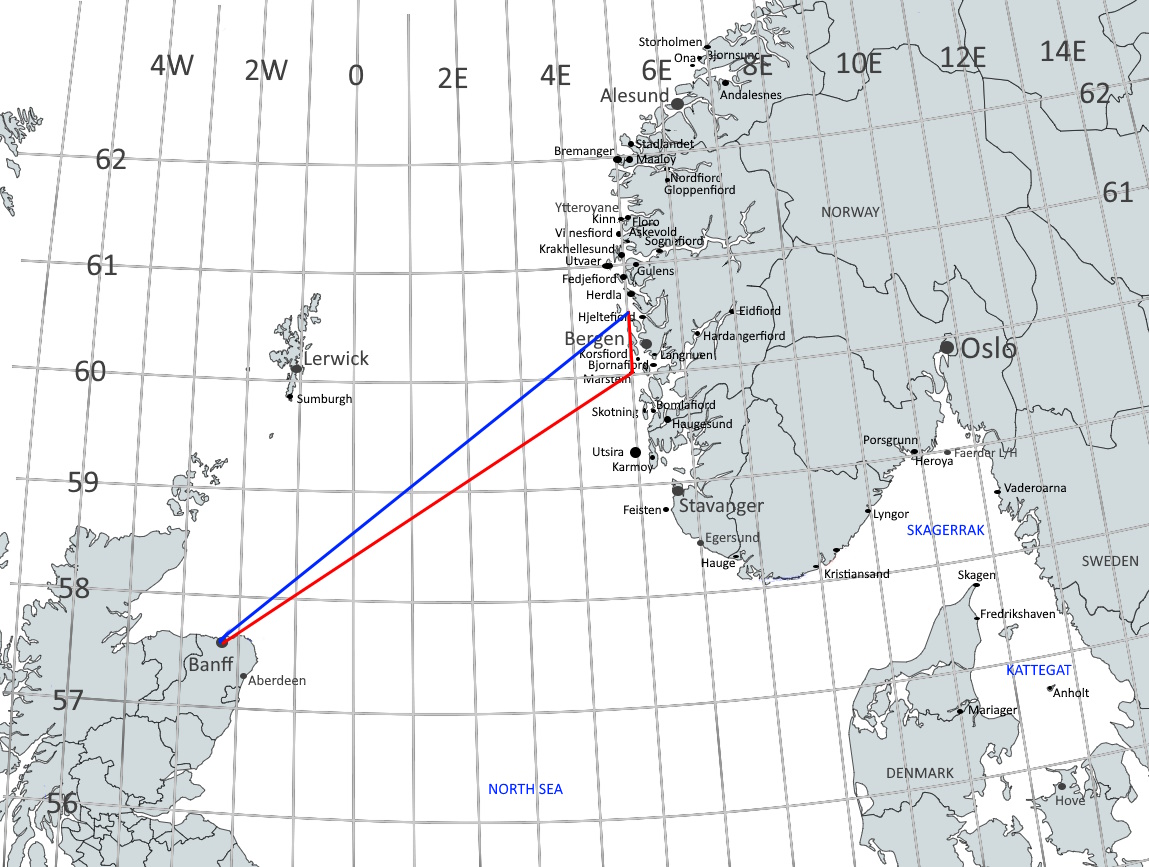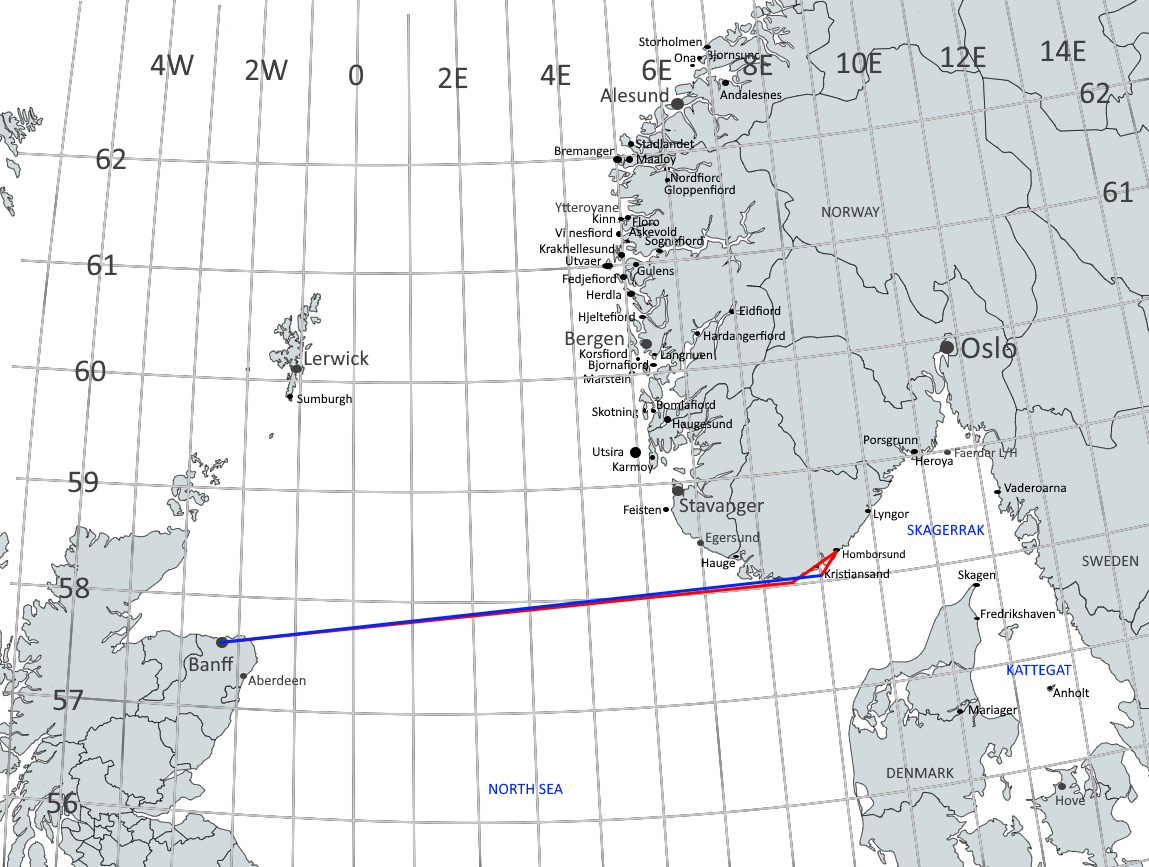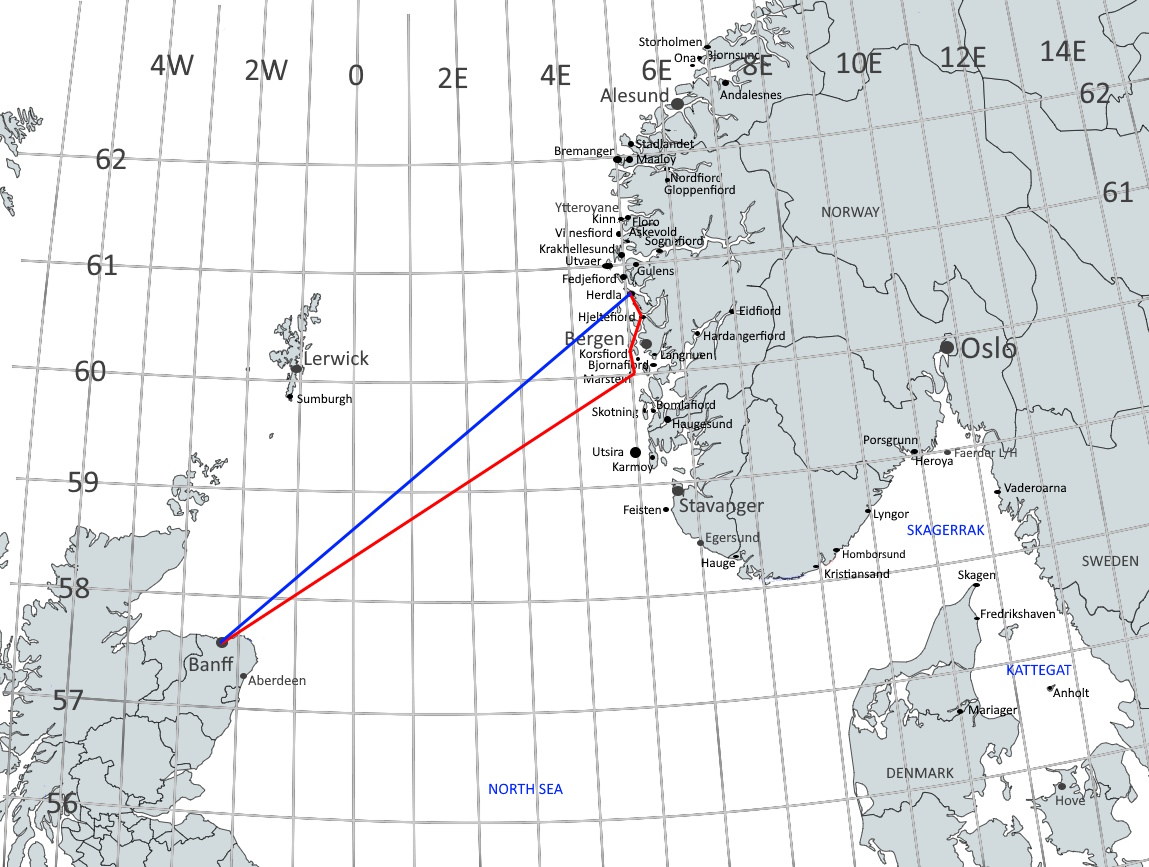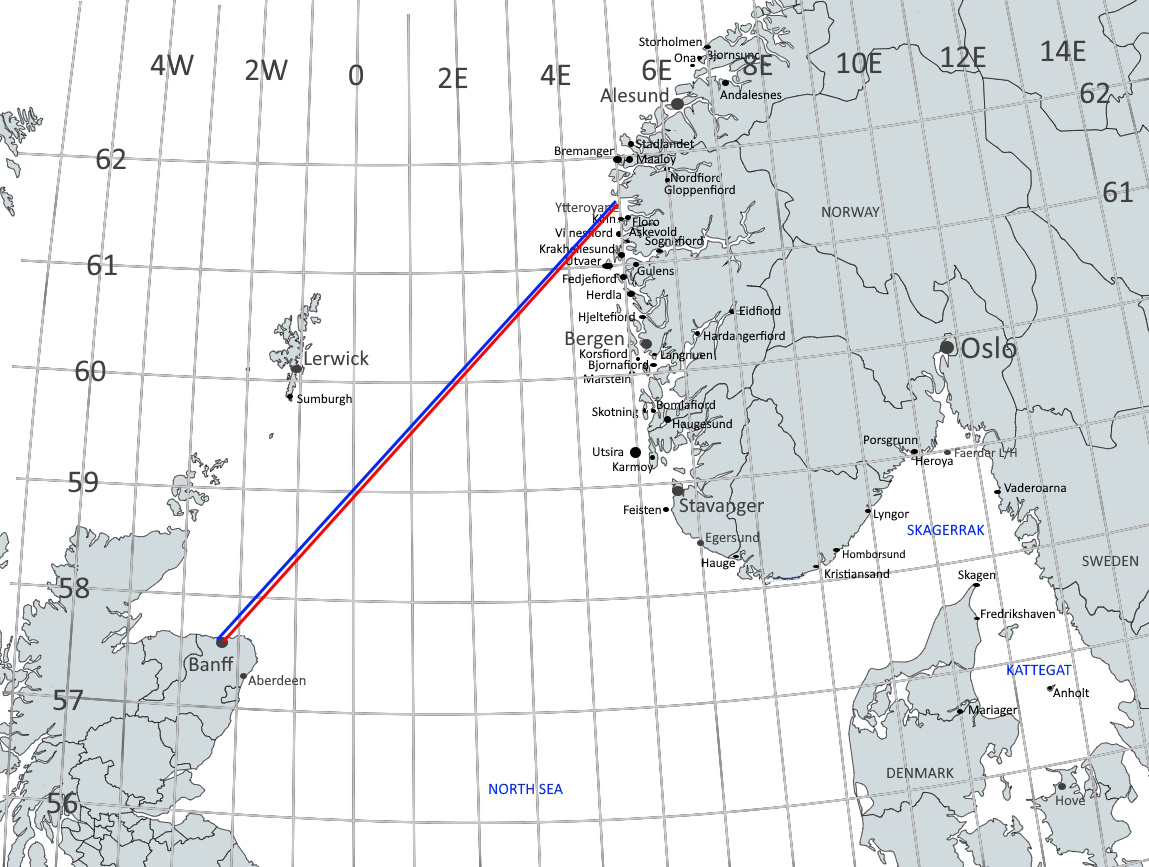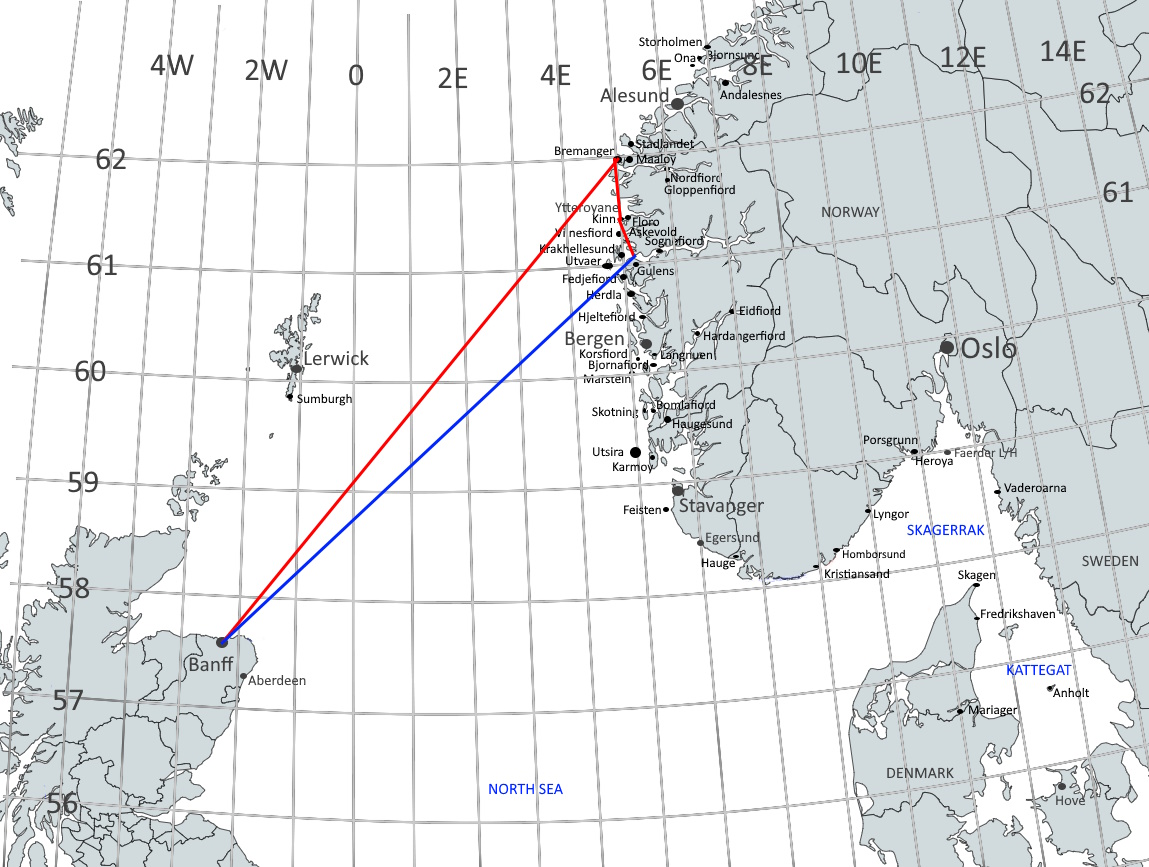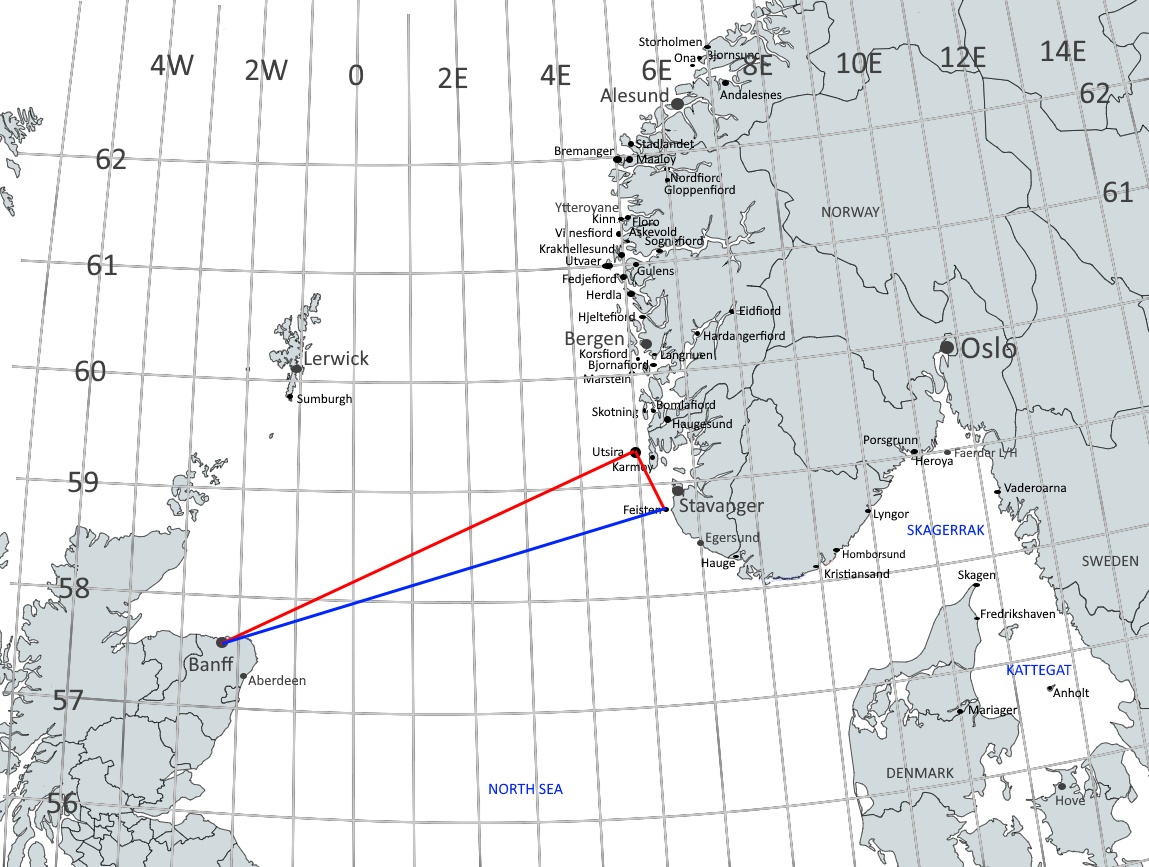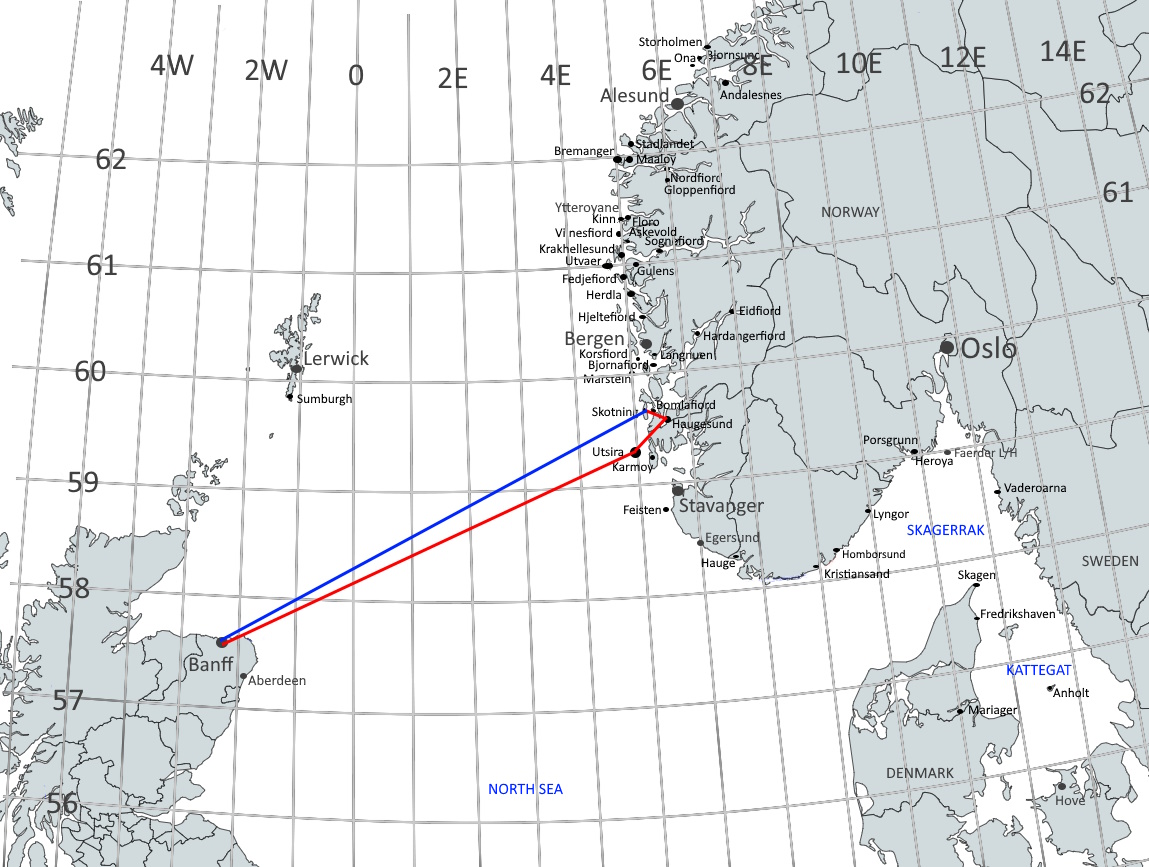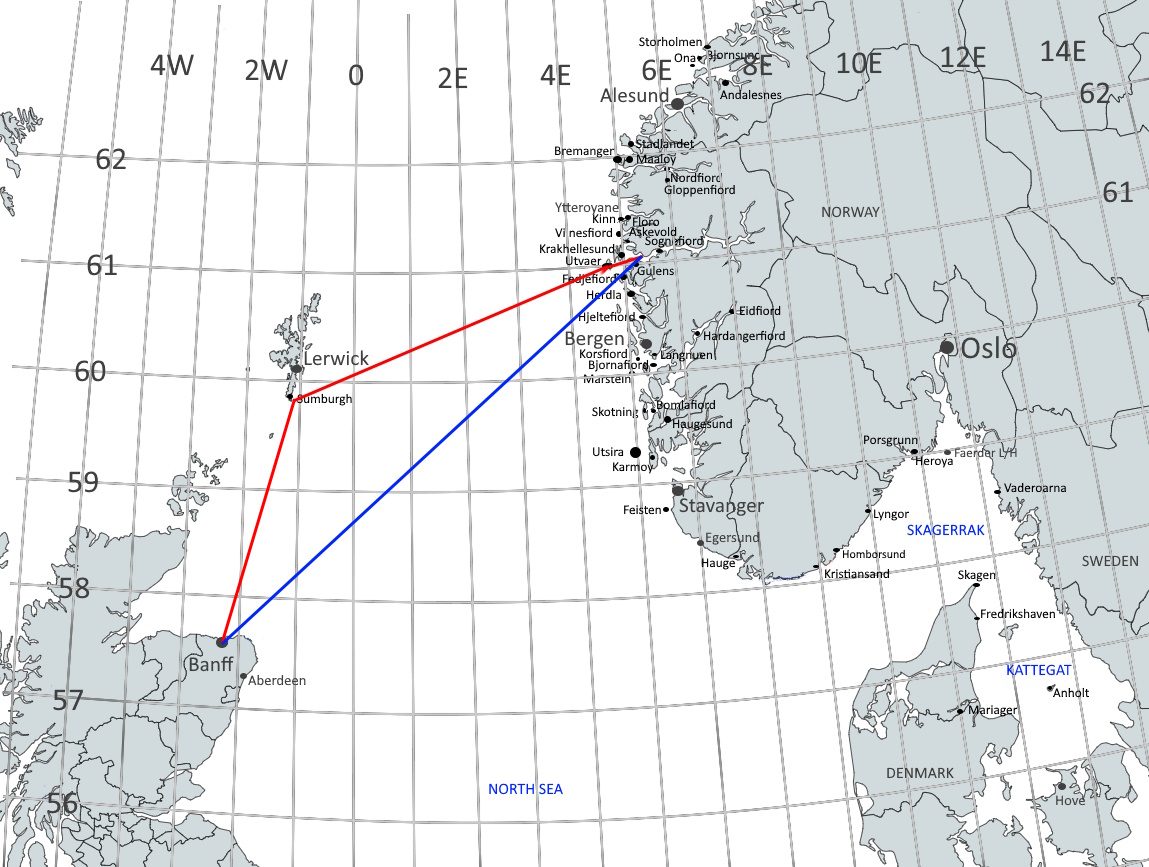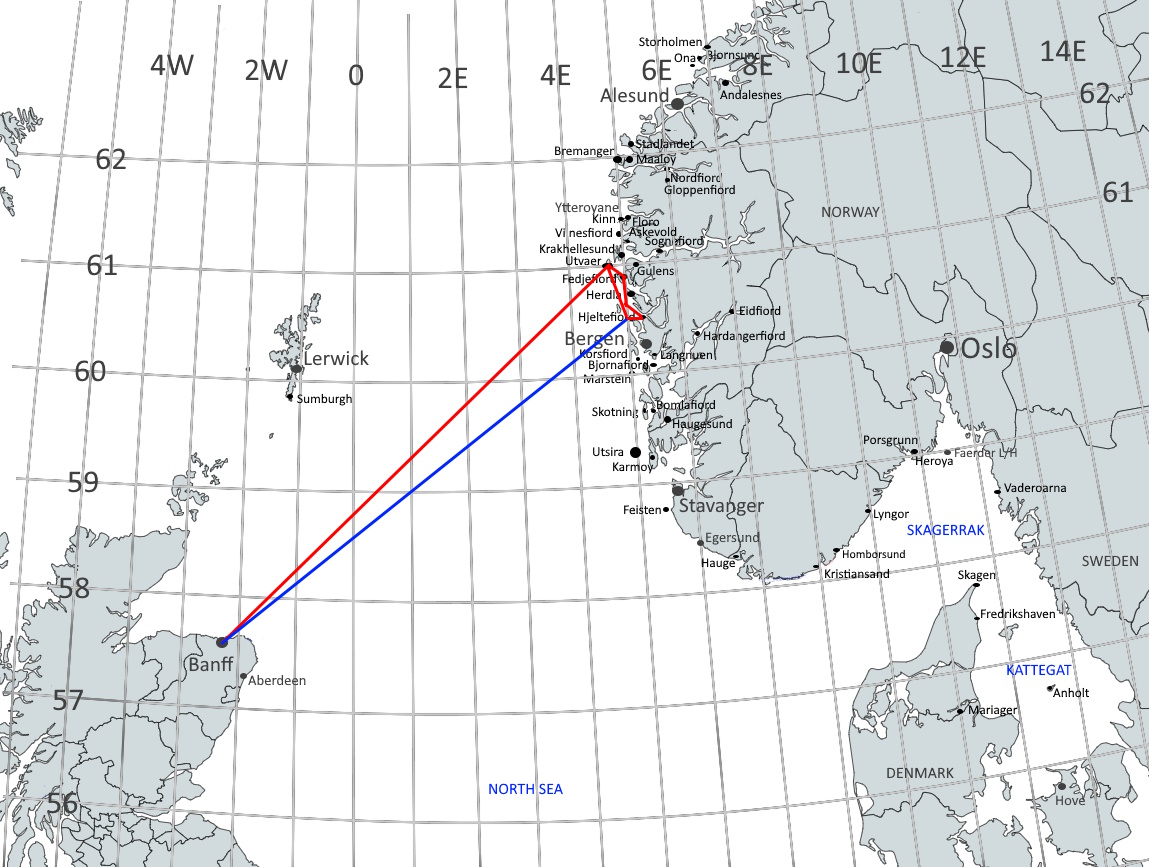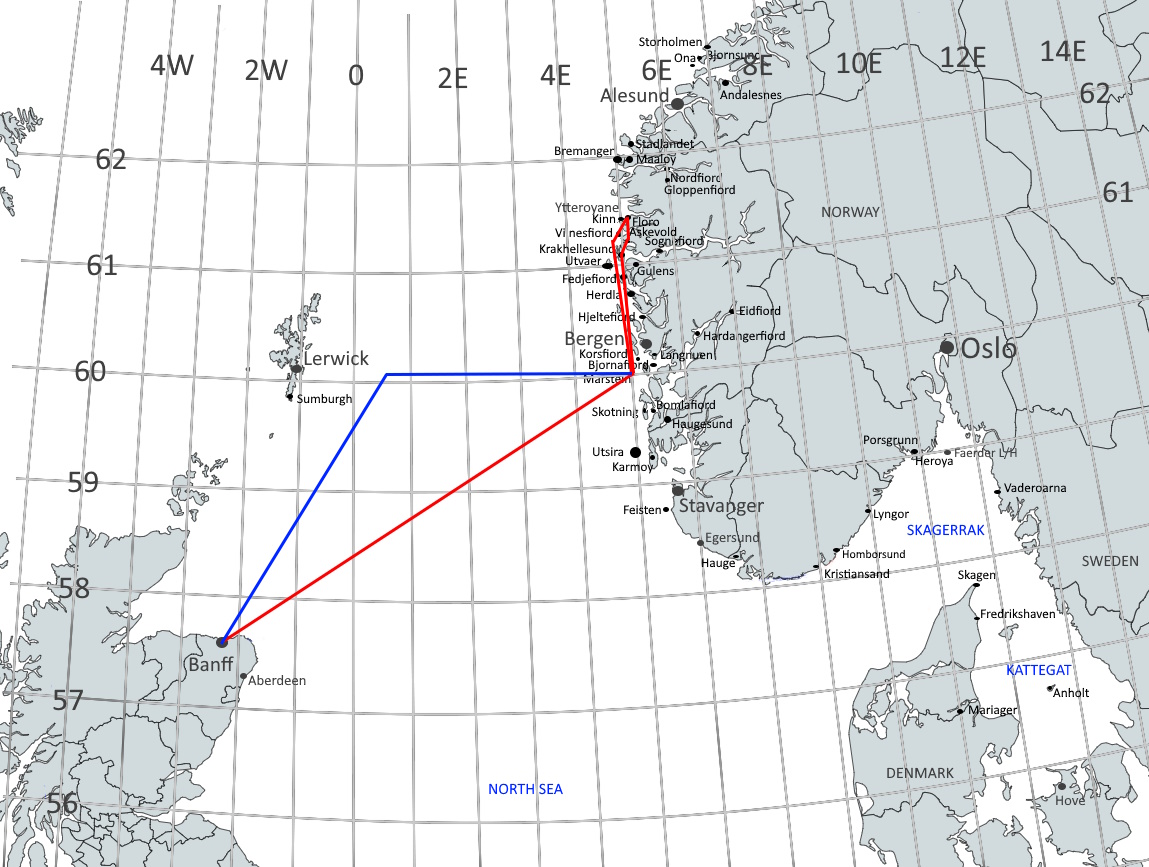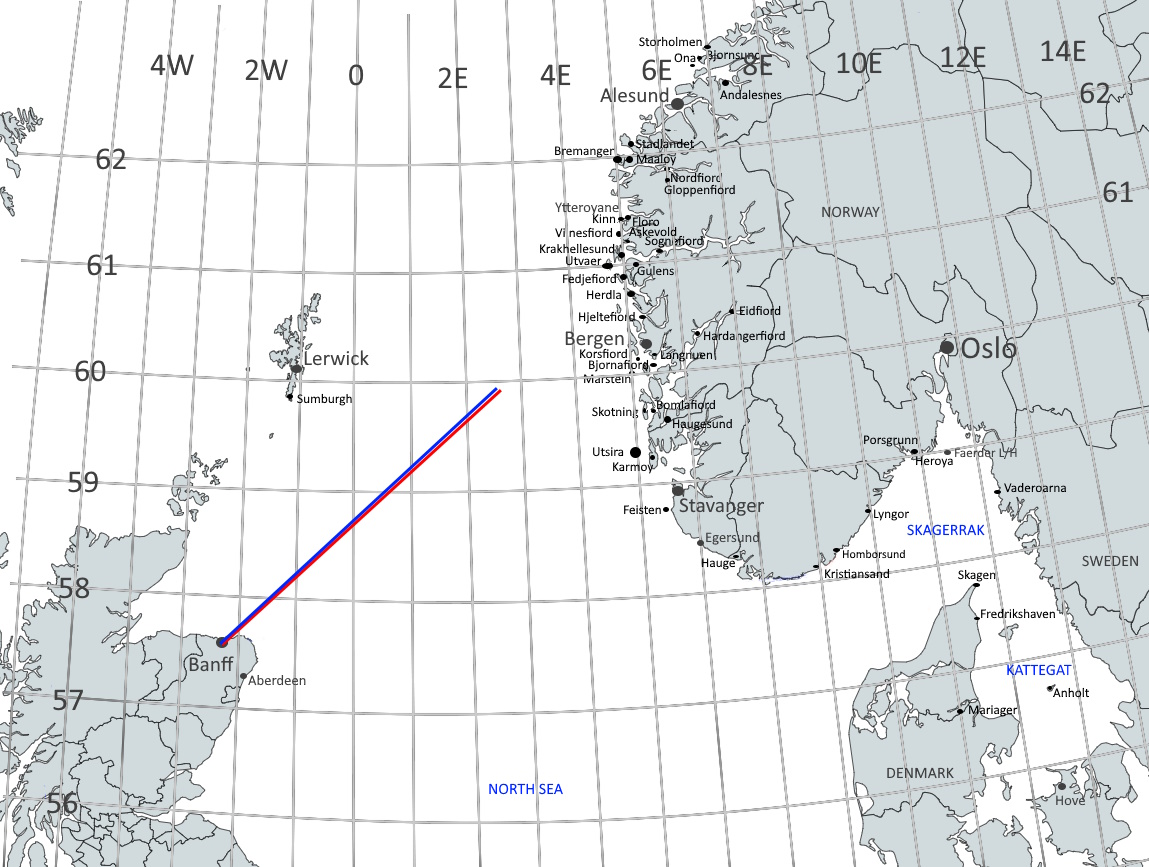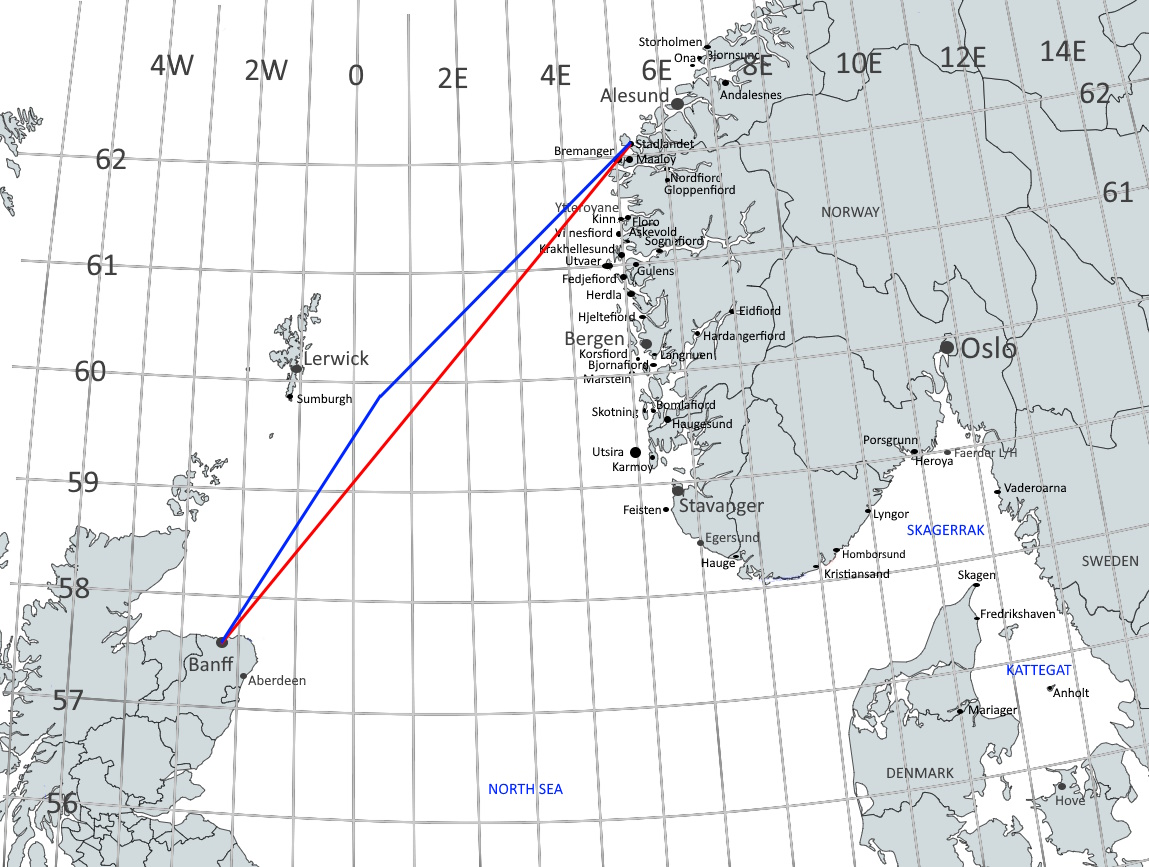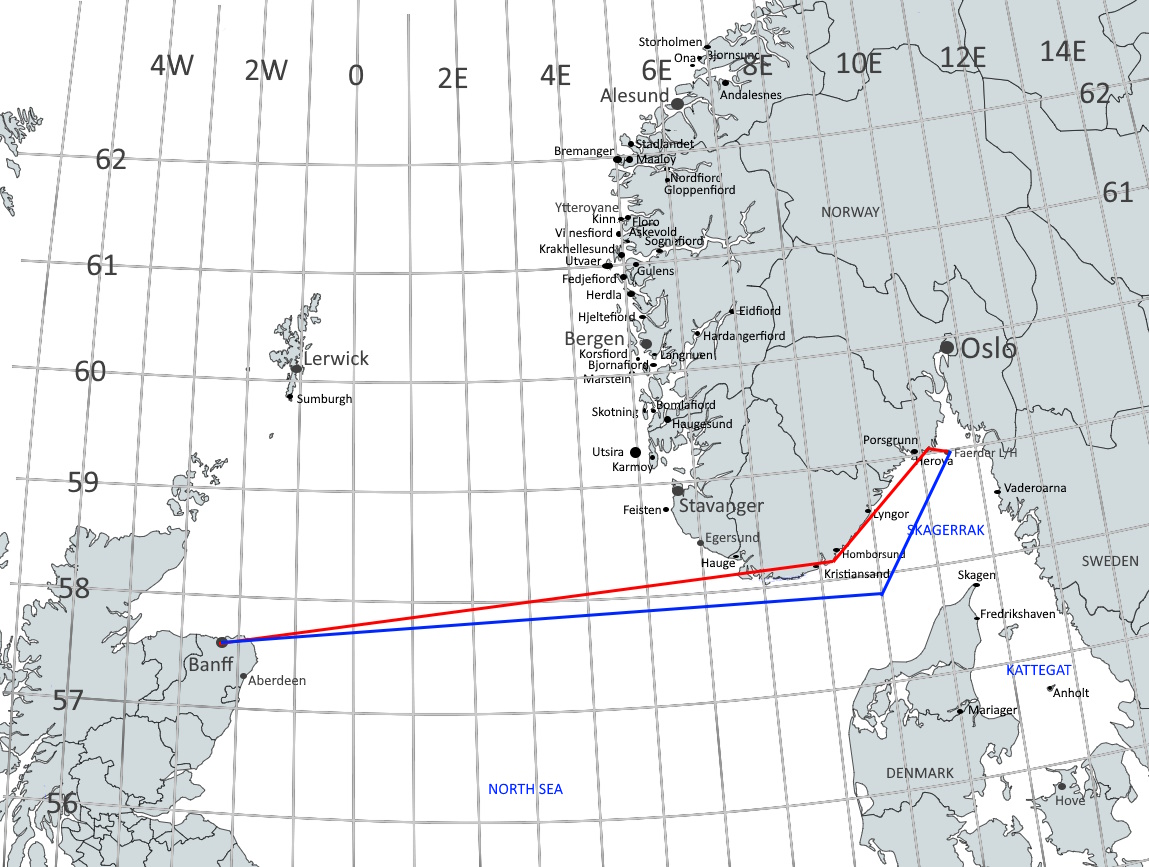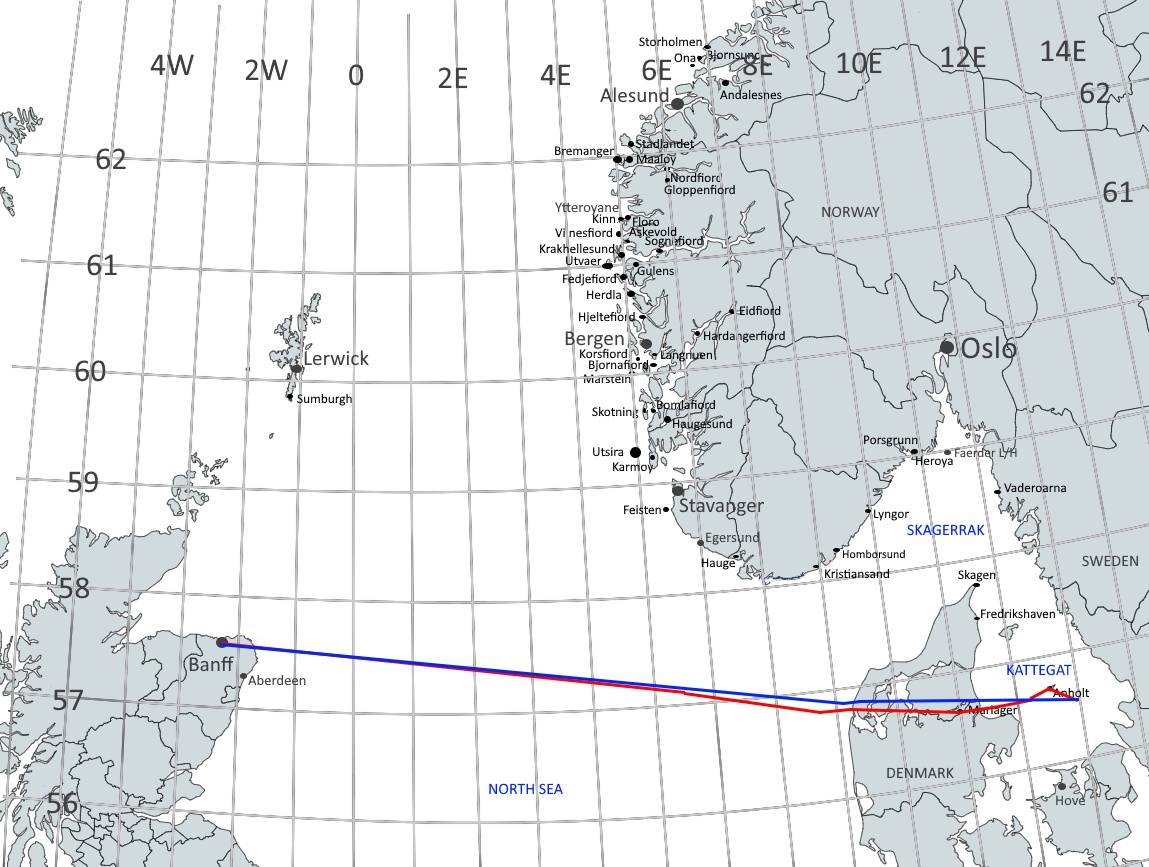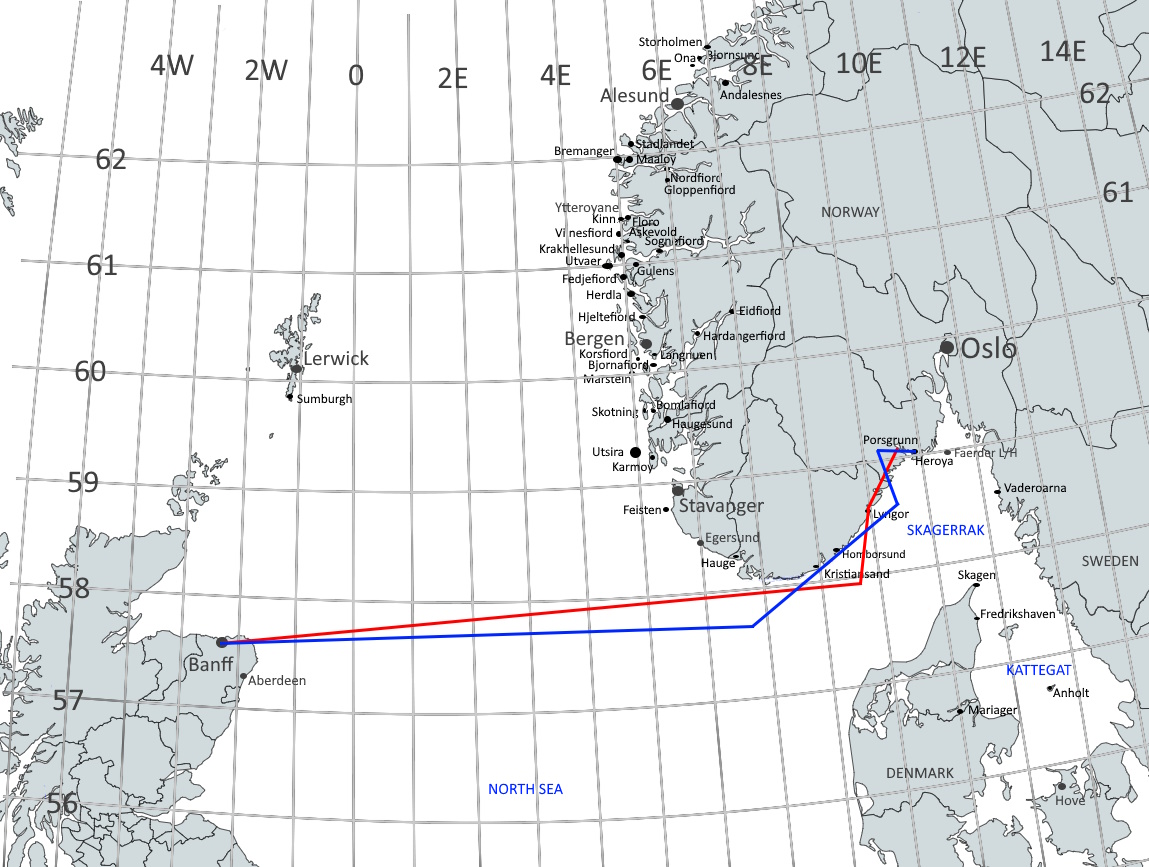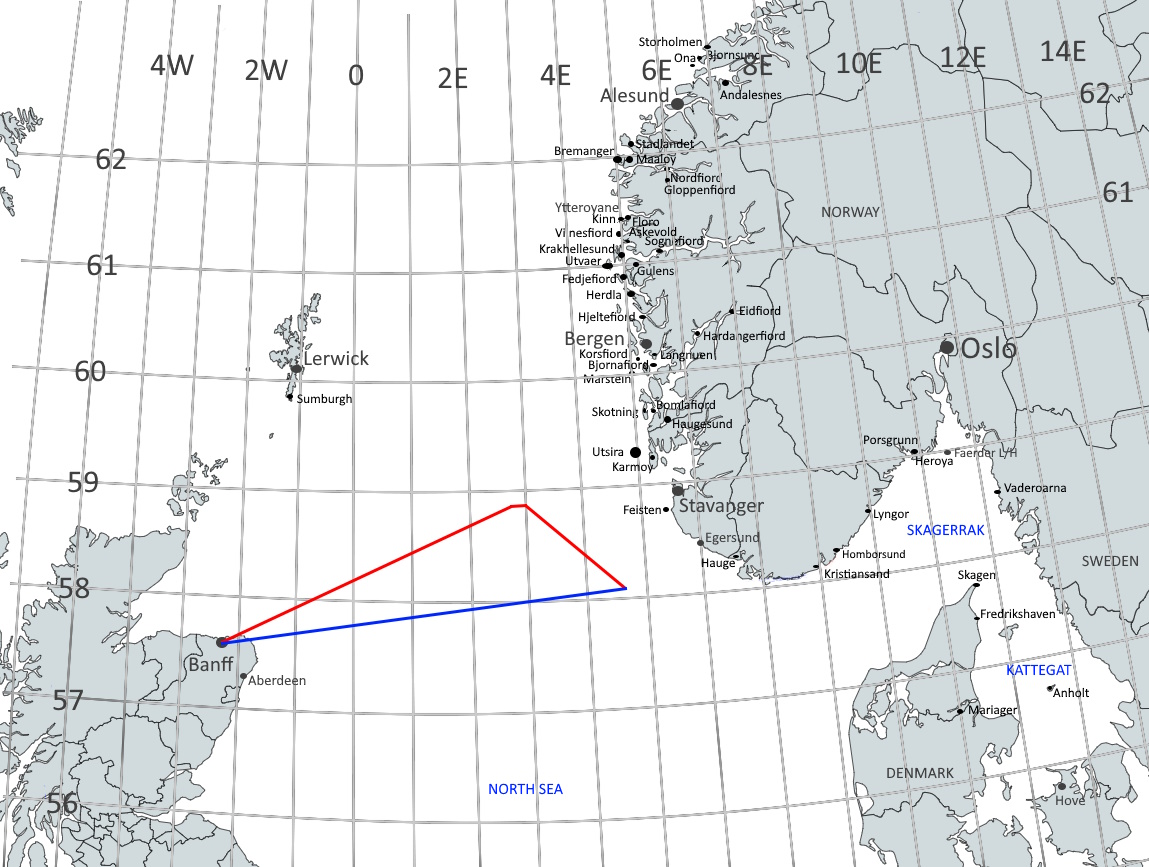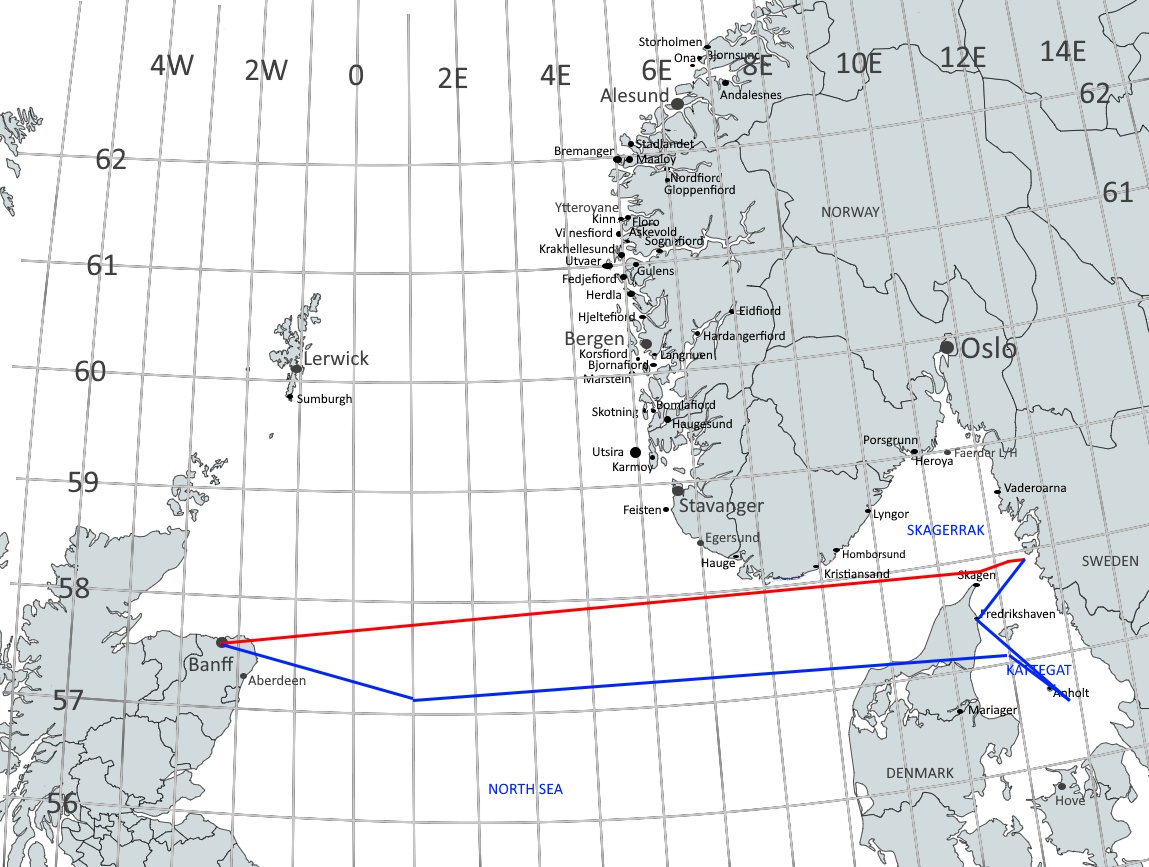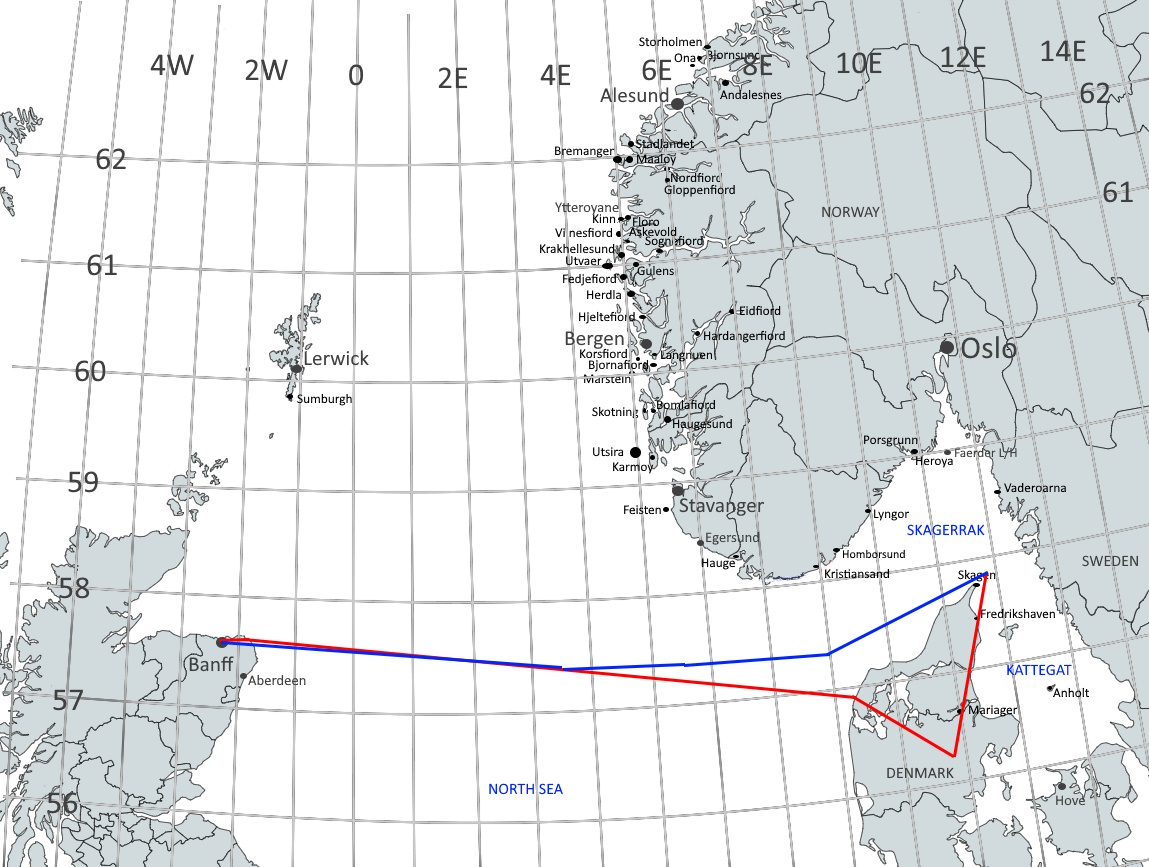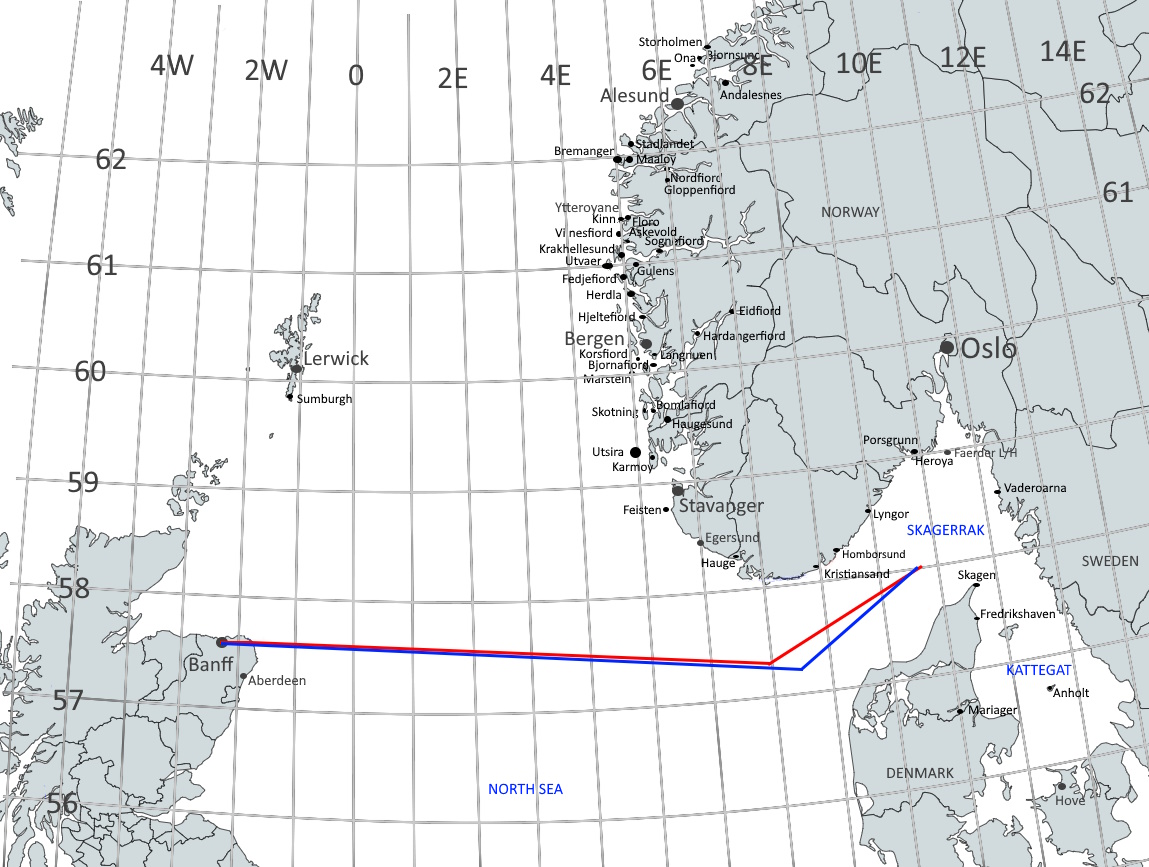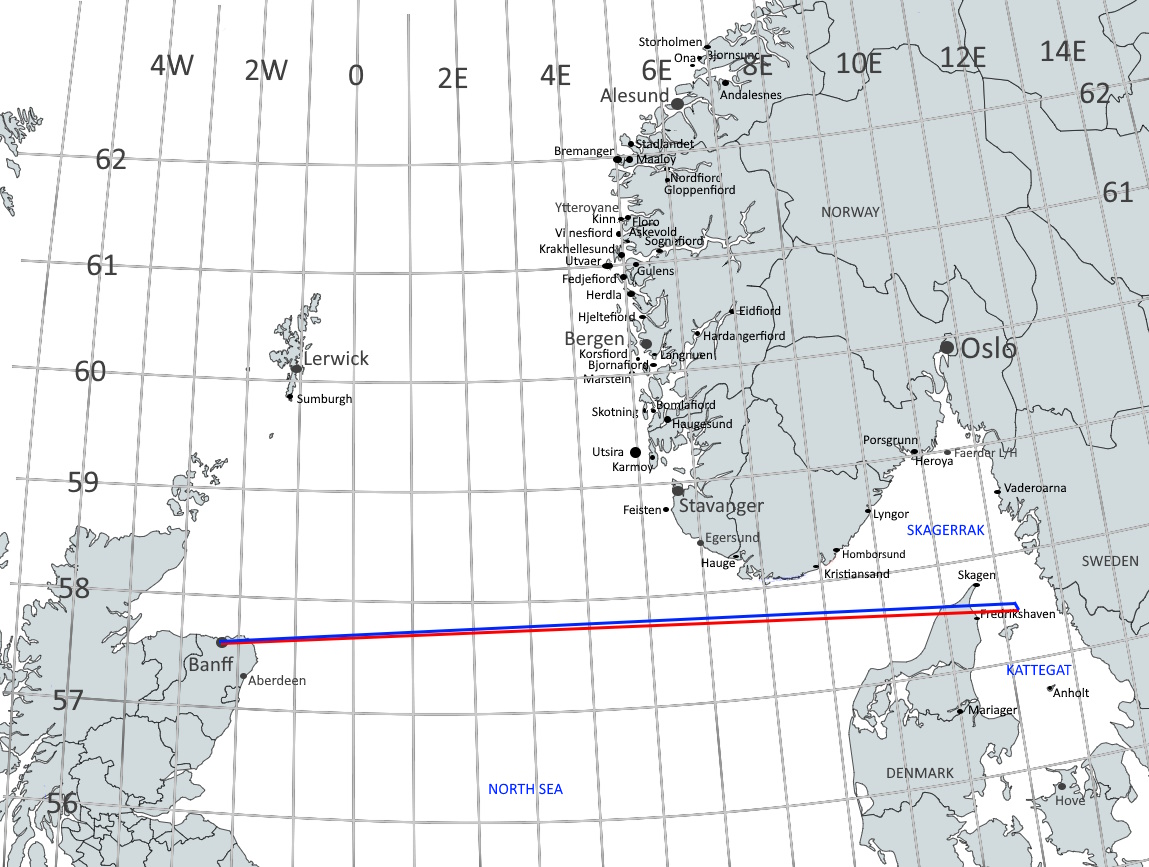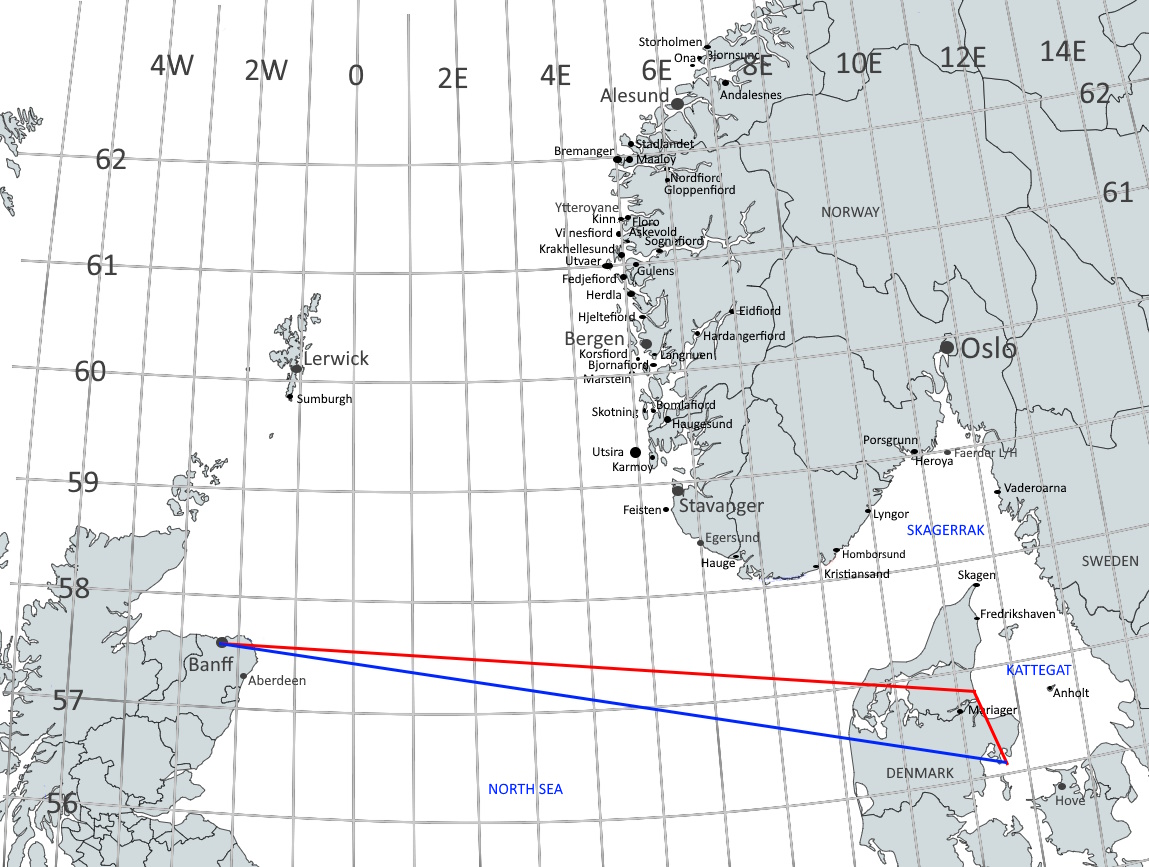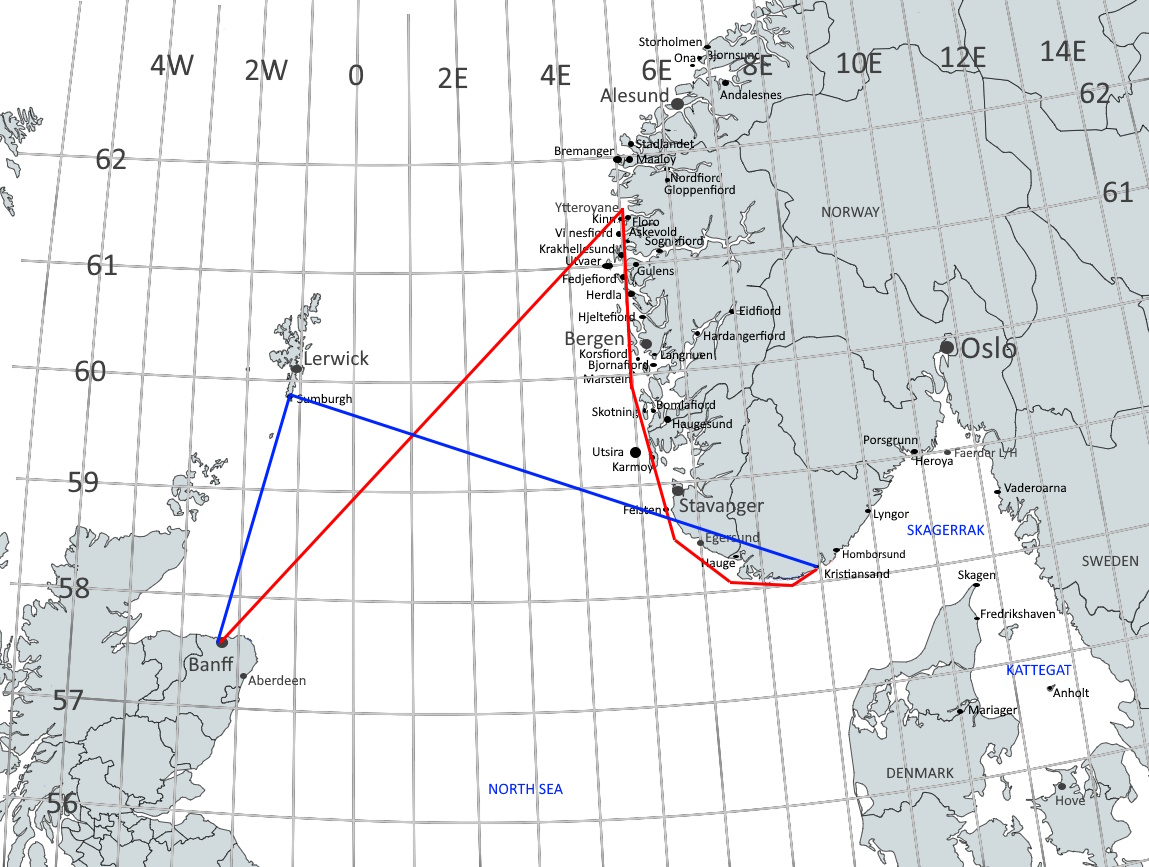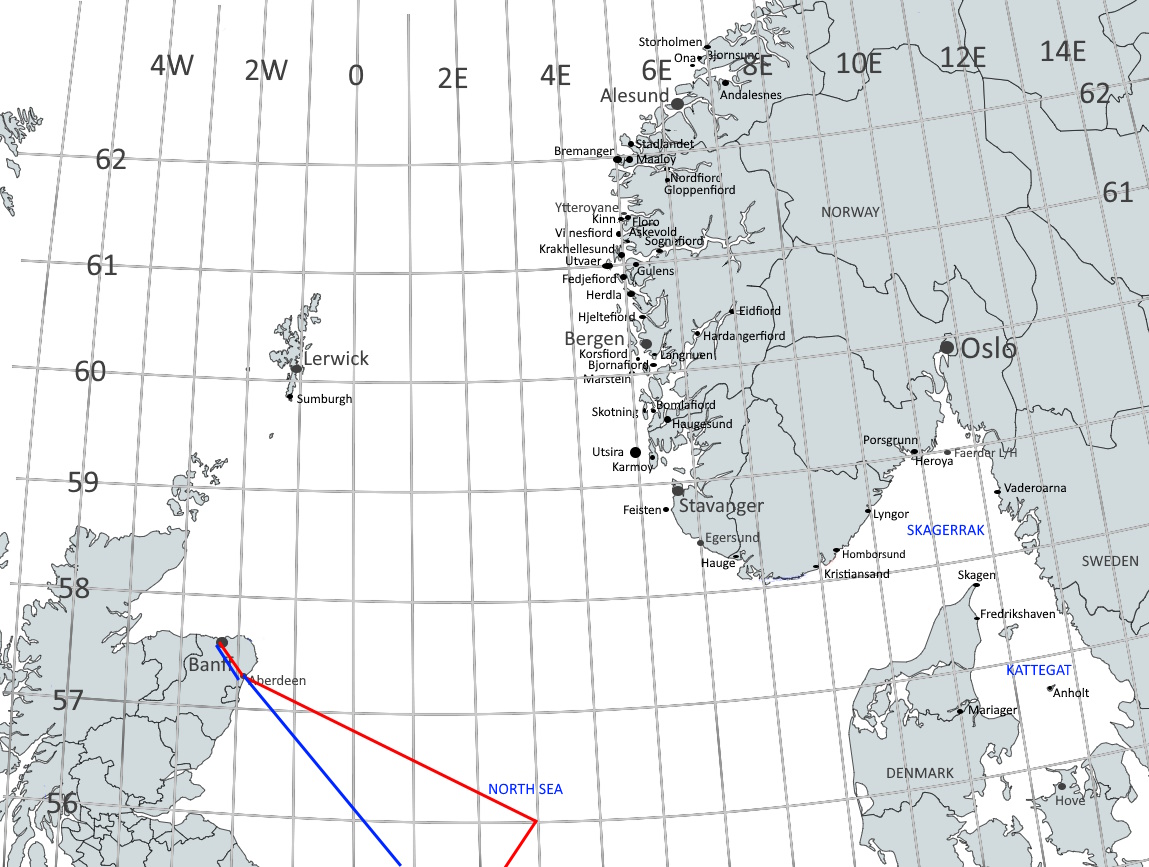THE VILLAGERS OF COLLINGHAM AND LINTON WHO SERVED IN WORLD WAR TWO
COLLINGHAMANDDISTRICTWARARCHIVE.INFO
 CONTACT
CONTACT



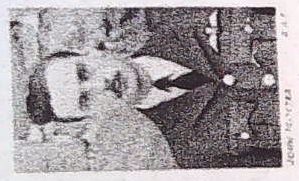
Rank Flight Lieutenant
Service Number 118950
Service RAF
Unit 235 Squadron Coastal Command
Regiment Royal Air Force
- Listed on an illustrated list of Linton Parishoners who served
- Address in 1939 or 1945/46: Halstock, Linton
(taken from either the 1939 National Registration or the 1945 and/or 1946 service electoral rolls)
Biography
Family background
Anthony John Charles Proctor (sometimes Procter) was born on the 20th February 1921 and baptised on the 3rd April 1921, the son of Arthur Proctor (1888-1934) and Kathleen Ella Proctor (1883-1934). At the time of the 1921 census, Arthur, aged 33, was a wirework manufacturer and director of Procter Bros. Wirework Ltd. of Call Lane, Leeds. He had been born in Boston Spa. Kathleen, his wife, was carrying out domestic duties and was aged 38 years 10 months, from Ripon. Anthony's elder sister, Elizabeth Skaife Proctor, aged 6 years 4 months, was from Wetherby, and the census records Anthony as being 4 months old, having been born in Headingley. With them at Four Gables, Boston Spa were two general domestic servants, Amy Powis, aged 19, and Emily Maria Backer, aged almost 16, both from Tadcaster.
In 1934, when Anthony was aged 13, both his parents died. Arthur on the 20th July 1934, aged 46, and just a few weeks later, on the 27th September 1934, Kathleen, aged 52. Local newspaper articles provide a few brief details:
The funeral of Mr. Arthur Procter, of Four Gables, Boston Spa, of the firm of Procter Bros., wireworks, Leeds, took place yesterday at the Parish Church. The Vicar (the Rev. E.A.S. Littlewood) conducted the service.
The principal mourners were: Mrs. A Procter (widow), Miss Elizabeth Procter (daughter), Master John Procter (son), Mr Jack Procter (brother), Miss Lucey Procter (sister), Mr and Mrs E A Odgers (brother-in-law and sister), Mr and Mrs R C Davies (brother-in-law and sister), Mr G F Wolstenholme (brother-in-law), Mr and Mrs Frank Wolstenholme (brother-in-law and sister-in-law), Mrs Coop (sister-in-law), Miss R Wolstenholme and Miss M Wolstenholme (sisters-in-law), Mr and Mrs Howard Procter (cousins), Mr Reg Procter, Mrs Noel Pyman, Miss Kathleen Procter, and Mrs Olive Maude (cousins). There were over eighty of the firm's staff present.
Mrs. Procter, of the Four Gables, Boston Spa, has died.
She was the widow of the later Mr. Arthur Procter, wireworker, of the firm of Procter Bros., Call Lane and Whitehall Road, Leeds, who died nine weeks ago.
Mrs. Procter recently underwent an operation.
At the time of the double loss of their parents, Elizabeth, Anthony's elder sister, was 19, and Anthony was 13, so we think it is likely that Elizabeth looked after Anthony as he was growing up. They moved out of Four Gables in Boston Spa, and by 1939 they were registered at Lincroft, on Tripp Lane, in Linton. Elizabeth was recorded as undertaking unpaid domestic duties, the abbreviation at the time for being a housewife, while also being listed as an ambulance driver. Anthony was listed as an apprentice wire worker, so was training to follow his father's footsteps into the family business.
Two doors away from the Procter family, at Halstock, Tripp Lane, Linton, was a family headed by Hannah Treliving and her husband Norman, a librarian, and their daughters Margaret W Treliving and Winifred J Treliving. Margaret was a teacher of shorthand, and Winifred was a student. We will return to Margaret Treliving later in our story.
Anthony's sister, Elisabeth Procter, married in early 1940 to Mr. Thomas Frost of Headingley. Thomas was serving in the R.A.M.C at the time.
Service record
Anthony John Charles Procter enlisted in the RAF on the 26th November 1940 at Number 3 Recruits Centre RAF at Padgate near Warrington. He was immediately placed in the reserve until he was called up. He was 19 years 9 month old.
His call up came on the 17th May 1941 when he reported for duty at Number 1 Recruiting Wing (1RW) , Torquay, which was based at the Norcliffe Hotel in Babbacombe. Here he would have been inducted into the RAF. He spent only five days there before being posted to Number 12 Initial Training Wing (12 ITW) at The Marine Hotel in St.Andrews, Scotland. Here Anthony would have learned the ways of the RAF while being assessed for suitable roles. After two months, on the 23rd July 1941, he was posted to 51 Group Pool. This was part of Flying Training Command and it may be that he had already been selected as Pilot material. On the 13th September 1941, Anthony was listed as being at RAF Cranwell and it was while he was at Cranwell as a Cadet that Anthony married.
On the 6th December 1941, Anthony Procter married 'the girl next door', Margaret Treliving, who had lived with her family two doors away from the Procters when they moved to Linton in 1939. The local newspapers provide some information about their wedding which took place while Anthony was already under training in the RAF:
At St. James's Church, Wetherby, to-day, Cadet A. John C. Procter, of Linton, Wetherby, a member of the firm of Procter Bros., Leeds, and son of the late Mr. and Mrs. Arthur Procter, of Four Gables, Boston Spa, was married to Miss Margaret Treliving, daughter of Mr. and Mrs. Norman Treliving, of Linton. Wetherby.
The Rev. L.P. Milnes officiated and the bride was given away by her father. Duchess lace trimmed her white satin dress, and her veil was of Honiton lace.
She was attended by her sister, Mrs. Anthony Harvie, and Mr. J.W. Thompson was best man.
On the 31st December 1941 Anthony Procter became a Leading Aircraftman and the following month, on the 23rd January 1942, he was promoted to Sergeant, perhaps marking the end of part of his training, and the following day, the 24th January 1942, he was commissioned as a Pilot Officer. A few months later the London Gazette announced on the 19th May 1942, that Anthony John Charles Proctor was appointed as Pilot Officer (emergency) with effect from 24th January 1942, with a service number of 118950.
In February 1942 (23rd Feb) Anthony was sent to RAF Squires Gate near Blackpool on a navigation and reconnaissance training course at No. 3 School of General Reconnaissance (3 S of GR). Having passed this part of his training Anthony was almost ready for operational duties, and so was posted to No. 2 (Coastal) Operational Training Unit (2 (C)OTU). Here he would have undergone final training to rady him for full operational flying. 2(C) OTU was based at RAF Catfoss, 4 miles west of Hornsea in Yorkshire, and close to the North Sea. RAF Catfoss was part of Coastal Command and No. 2 (Coastal) Operational Training Unit trained crews on the command's twin-engined fighter and strike aircraft. The unit also trained Bristol Beaufighter crews for deployment to Far East and Middle East squadrons, and it was to the Middle East that Anthony Procter was destined to be sent.
His record shows that on the 20th August 1942, Pilot Officer A J C Procter was posted to 272 Squadron. It would have taken some time for Anthony to get to the Middle East and his record does not detail how he made the journey, but on the 2nd October 1942 the Operational Record Book of 272 Squadron records that (P/O Proctor) arrived with his navigator/observer, Flying Officer Young, at RAF Edku in Egypt to serve with 272 Long Range Fighter Squadron RAF. 272 Squadron was equipped with Bristol Beaufighters and was the first properly equipped long range fighter squadron to reach the Mediterranean theatre. It was operating in the Western Desert as a ground attack squadron, attacking enemy aerodromes, transport aircraft and lines of communication and in carrying out convoy escort duties. In October 1942 it was based at RAF Edku (sometimes RAF Idku) near Alexandria in Egypt.
While in Egypt, on the 27th November 1942, probationary Pilot Officer Proctor was promoted to probationary Flying Officer, with effect from the 1st October 1942. The Operational Record Book shows that Anthony Procter's first operational flight with the Squadron took place on the 19th October 1942.
First trip
19th October 1942.
TNA AIR27/1577/34
TNA AIR27/1577/33
Anthony Proctor flew in this raid with 'A' flight. It was clearly a very eventful first operational sortie involving a shipping attack and an attack on German Junkers Ju-52 transport aircraft towing gliders, and themselves being attacked by twin-engine Messerschmidt Me-110 fighters.
Second trip
Anthony Proctor's second trip was in a ground attack role, harassing German transport and supply routes between Barrani and Sollum.
TNA AIR27/1577/34
TNA AIR27/1577/33
Third trip
TNA AIR27/1577/34
TNA AIR27/1577/33
The 25th October 1942 was slightly cloudy but fair, when 272 Squadron were tasked with an air patrol against German aircraft. They took off about 11.16 am and formed a strike section and a top-cover section tasked with defending against higher level fighters. The strike aircraft were 'G' (F/Lt Watson and P/O Cutting), 'B' (W/Cdr White and F/Sgt Francis), 'D' (P/O Proctor and P/O Young) and 'E' (Sgt Russell and Sgt Wilson), while top-cover was provided by 'W' (F/O Rankin and P/O Pinkerton), 'Y' (P/O Palmer and Sgt Trotman), 'T' (P/O Patterson and Sgt Sinister) and 'P' (Sgt Hains and Sgt Lawson). The patrol was a low altitude patrol around 50 feet. Having crossed Abukir they set a course of 227° until they reached 33 00 N 23 40E when they commenced the patrol on course 12°. They sighted 33-35 Ju 52s to the North West, flying on a course of 180° and about 100 feet in a fairly tight formation. At 33 20N 23 58E they attacked the enemy aircraft.
The enemy formation was composed of at least 33 Ju52 transport aircraft, escorted by 4, or possibly 6 Me110 fighters. The Ju52s were in fairly compact formation with no gliders. The Me110s were above at 2000 feet. The Beaufighters were on a course of 12° when they sighted the enemy ahead and slightly to starboard. The strike aircraft immediately turned towards the enemy while the top-cover started to climb to engage the fighters.
Flying Officer Rankin led the top-cover to engage the escorting Me110s and got to about 1500 feet when the leading 110 dived at him from head on, opening an ineffective fire at fairly long range. F/O Rankin held his fire until close range and then fired a short burst. Pieces were seen to fly off the enemy which dived away steeply and was to seen again. After that a general dog-fight ensued with all of the top-cover being engaged by one or more Me110s. The Beaufighters worked in pairs, protecting each other's tails, and used the cloud cover to counteract the German fighter's greater manoeuvrability. They kept the majority of the enemy away from the Strike section.
By this stage the air was a mass of aircraft. Sgt. Hains had been chased by a Me110 for some distance before getting away and re-met the Ju52s when the other Beaufighters had left. The coast of North Africa was visible, and the only ME110 that he could see was on the same course as himself, so he attacked a Ju 58 from the beam. It continued flying with the rest of the formation, but he saw smoke pouring from the centre of the fuselage. Claimed as damaged. Meanwhile F/Lt Watson had led the striking force at the Ju 52's. His first attack, from the beam, resulted in large pieces falling off the enemy aircraft's tail. He broke away and took evasive action to dodge the formation's return fire, and as he circled to make a second attack, his observer saw the enemy aircraft just under the surface of the water. He made six or seven attacks in all, closing to 100 yards on several occasions, but in each case the necessary evasive action prevented observation of the results. During his third attack he saw a brilliant flash, and a Ju 52 exploded near the centre of the formation and, in addition, a column of smoke was seen to be rising from the sea. During his fourth attack he has an impression of seeing two aircraft, one of them, at least, a Ju 58, collide, but is unable to state definitely that it occurred. He and his observer at one time definitely saw a column of smoke rising from the sea. Two ME110s stayed over the Ju 52s and attacked our aircraft as they came in, making it almost impossible for the Beaufighters to make fully head on attacks. On F/Lt Watson's second attack a Me 110 opened fire from astern but P/O Cutting replied with his rear gun and saw his tracer hitting the enemy aircraft, who thereupon sheared off. Sergeant Russell sent one JU52 crashing into the sea in flames with his first burst, and, on his second attack, scored hits on another, but found a ME110 on his tail, which cut short his observation. The Me110 attacked most determinedly and followed at 260 knots for 10 minutes, during which time he made five attacks. Each time Sergeant Russell's evasive action saved him, and ultimately Sergeant Wilson got in a good burst with his Vickers gun and the enemy aircraft turned steeply and made off. Sergeant Russell's aircraft was hit in the port oil tank but he just managed to make base. P/O Procter made four attacks on Ju 52's, but evasive action and Me 110 attacks made observation of results impossible. He confirms that 3 columns of smoke which were going skywards at one time. It is not known what happened to our C/O, Wing Commander White. There is little doubt that it was he who destroyed the Ju 52, seen to explode by F/Lt Watson, as mentioned above. This would account for one column of smoke, Sergeant Russell's victim a second, but it is impossible to tell which of the Ju 32s attacked was responsible for the third. Certainly four JU52s were destroyed and, if the collision was a fact, undoubtedly a further two. It is conceivable that it was Wing Commander White's aircraft that was involved in the collision.
Whatever happened to Wing Commander White and his observer, they did not survive.
41640 Wing Commander John Mortimer White,
996910 Flight Sergeant Richard Andrew Francis, aged 28, son of Henry and Violet Helga Francis; nephew of Mabel Francis, of Fakenham, Norfolk.
Neither body was found and both are commemorated on the ALAMEIN MEMORIAL which forms the entrance to Alamein War Cemetery. The Land Forces panels commemorate more than 8,500 soldiers of the Commonwealth who died in the campaigns in Egypt and Libya, and in the operations of the Eighth Army in Tunisia up to 19 February 1943, who have no known grave. It also commemorates those who served and died in Syria, Lebanon, Iraq and Persia. The Air Forces panels commemorate more than 3,000 airmen of the Commonwealth who died in the campaigns in Egypt, Libya, Syria, Lebanon, Iraq, Greece, Crete and the Aegean, Ethiopia, Eritrea and the Somalilands, the Sudan, East Africa, Aden and Madagascar, who have no known grave.
After the loss of Wing Commander White on the last trip, 272 Squadron's next operational sortie, and Anthony Proctor's fourth, took place the following day.
Fourth trip
The fourth operational trip made by Anthony Proctor was a largely uneventful trip escorting a shipping raid.
TNA AIR27/1577/34
TNA AIR27/1577/33
Fifth trip
Anthony Proctor's 5th operational flight was on the 2nd November 1942, and was a very eventful flight.
Anthony Proctor, accompanied by his observer, Pilot Officer Young, took off from Edku at 06.30 to escort a force of Beauforts against an enemy convoy approaching Tobruk. On the outward flight, Proctor, in Beaufighter 'H' for Harry, had engine problems and had to drop out of the raid. The aircraft never returned to base and a report on the circumstances of the disappearance was filed by Wing Commander Buchanan, Commanding 272 Squadron:
Pilot.- P/O A.J.C. Proctor.
Obs. - P/O E.A.C. Young
On 2/11/42, at 06.30 hours 7 Beaufighters took off from Edku to escort 6 Beauforts to attack an enemy convoy consisting of two M/Vs [Motor Vessels] escorted by a destroyer 50 miles North of Tobruk. P/O Proctor was in a/c [aircraft] 'H' and was flying as Number 2 to S/Ldr Watson until at 08.40 hours approximately 70 miles North of Tobruk he dropped out of position. He was not seen again. A formidable air escort was encountered over the enemy convoy and the probability is that the aircraft and crew were lost through enemy action.
for Wing Commander, Commanding,
No 272 Squadron., R.A.F.
MIDDLE EAST.
The next of kin of both P/O Proctor and P/O Young were informed both by telegram and letter:
Madam,
I am commanded by the Air Council to confirm the telegram in which you were notified that your husband, Pilot Officer Anthony John Charles Procter, Royal Air Force, is missing as the result of air operations on 2nd November, 1942.
The only information contained in the telegraphic report from Royal Air Force Headquarters, Middle East, is that your husband was Captain of a Beaufighter aircraft which has failed to return from a position approximately fifty miles north of Sidi Barrani, Egypt, and that the reason is not known. This does not necessarily mean that he is killed or wounded, and if he is a prisoner of war he should be able to communicate with you in due course. Meanwhile enquiries will be made through the International Red Cross Committee and from all possible local sources. As soon as any definite news is received, you will be at once informed.
If any information regarding your husband is received by you from any source you are requested to be kind enough to communicate it immediately to the Air Ministry.
The Air Council desire me to convey to you their sympathy in your present anxiety.
I am, Madam,
Your obedient Servant,
Mrs. A.J.C. Procter,
Halstock,
Linton,
Wetherley (sic),
Yorkshire.
So what had happened to 'H' for Harry and its occupants, Pilot Officers Proctor and Young? Fortunately both survived and Pilot Officer Proctor reported in detail on the events and this report is now in The National Archive. P/O Proctor's report is written as a continuous report, but I have split it into separate days here.
[2nd Nov 1942]
On November 2nd, 6 Beaufighters of number 272 squadron took off at 06.45 hours to escort Beauforts on a shipping strike off Tobruk. I flew ‘H’ (for Harry). We cruised at 145 knots which necessitated some zigzagging at the rear of the formation. I flew up the middle with an occasional swap out to starboard. The aircraft contained four loose water bottles and I had my own slung under my Mae West. I also had a bag, with a strap, on my left containing some food, a spare pullover and 4 ground flares. In my Mae West was a floating torch and an escape kit.
At 08.25 hours, I changed from inner to outer fuel tanks, leaving fifteen gallons in the outer,. My observer reported oil flowing down the starboard wing outboard of the engine, the oil pressure and temperature were normal. At 08.35 hours, during a turn to the right, the starboard engine ceased pulling suddenly, the wing and nose fell, and the machine slewed round a full 90 degrees. While regaining control, I switched on the suction balance cock, opened up to full revs on the port motor and throttled up to 2½ pounds boost. I left the starboard throttle at -1 just in case I could get a helpful burst of power and reduced revs to about 1400. As I suspected a failure in the fuel system I called up my observer to come and change my tanks on the starboard engine back to outer but he had no sooner reached me, then it was obvious that I must land on the water. I shouted to him to get ready; he saw what was happening and braced himself. My speed was 120 and I was only 20 feet up so I reduced speed to 105 and lowered the machine foot by foot onto the water. We were still tending to turn to the right but we hit the water longtitudinally level and I have the impression of a terrific jar and then sliding along with water being thrown up over the nose. I got three bangs on the head, one from the gun sight, and two on the back of the head. When I opened my eyes and could see clearly, I found that the top hatch was open; I may have done it myself but I was temporarily stunned, and I doubt if it could be blown open. The starboard engine looked closer to me than usual and my instruments had been lost away, presumably by an air screw blade. My observer tells me that the after part of the fuselage was full of water and still rushing up through the cannon ejector holes. I had no trouble getting out through the top hatch with my parachute on, and slid off the starboard wing, which was underwater. My parachute immediately rose to the surface and pushed my head underwater, but in pulling my Mae West and rolling over onto my back, my shoulders came out of the water. I released my parachute harness and pulled out the dinghy which I partially blew up so that I could get it floating the right way up. That done, I fully opened the valve and climbed in and held the parachute after me. My observer had no ‘K type’ dinghy with him but had got out the aircraft dinghy with which he was struggling. I paddled over to him. The big dinghy was almost underwater so I pulled the air release wire and enough came out to lift most of the dinghy out of the water, but there were two large tears in the skin. I was able to block one with the largest stopper but the other was too big - I tried to tie it up with string which was useless. I was able to cut away two water bottles, two tins of emergency rations, and a marine distress signal which was not rubberized. I hoped to be able to get some long lengths of rope but was too exhausted and my observer was getting very cold, but I managed to get the paddles. In my hurry I had forgotten to collect my bag of kit, which proves that you must have everything tied to you as the aircraft sank in less than 15 seconds. My observer had gone off to try and support himself on an undercarriage wheel which was floating close by, but found that some of the retraction gear was attached and rods were stretching out in all directions.
I then made the ‘K type’ dinghy ready to take two by opening up the parachute and cutting off all the cords from the canopy. I wish now that I had left some of the silk cord as it would have been useful, but I let that and the harness sink. Then I tied all the water bottles on and the paddles to the dinghy. By sitting on the extreme end of the dinghy my observer was able to climb in without turning the whole thing over. The wheel and undercarriage had drifted rather close to us so we paddled away for fear we were punctured; there was practically no other debris. The sea was perfectly calm with no wind whatsoever, but we were very cold and shivering, so decided to paddle. It was almost pointless to bail out the water as every move brought in a fresh lot and as we were sitting close up with our knees against our chests, there was little room to manoeuvre. I felt very sick, due I think, to the large amount of salt water I had swallowed, and the sudden chill. As my helmet was soaked, I took it off and threw it away - we had no room in the dinghy. I noticed that it had split down the back. On checking over rations I found that we had three water bottles, two tins of rations and two escape boxes. As we decided that we could not last long in such cramped quarters, we would continue paddling south; the parachute was hoisted onto the dinghy and laid round the walls so as to offer less resistance. On examining the dinghy container, I found that we had a full set of bungs, but neither flag nor mast. I should like to support, that the whole of the flag, including the white spot, be rubberized to make a useful catch for rainwater. All the small complete compasses we had were full of water, one even containing liquid’ Horlicks’, but the fly-button type was successful. Both our watches had stopped as a result of seawater.
We heard aircraft approaching from the east, and the whole of our own force flew overhead; we waved the parachute but they were looking directly into the low sun. We paddled on and off, in turn, and together for the rest of the day, but by observing bits of wood we saw that we made little headway. At about midday a CANT.1007 flew over at 15,000 feet, but we did not even bother to wave. During the afternoon quite a swell developed but the slight breeze was very indefinite. As the sun got low, the temperature dropped rapidly and we made preparations for the night by tying the paddles securely to the dinghy, dropping part of the parachute into the water, and using the rest as a tent. I tied the back sheet of the dinghy round my waist, and my observer pulled up the front portion over his knees. By this time we both had horrible pains in our knees but nothing could be done, we just sat and shivered. Owing to the night, a slight wind blew up, making small waves which washed into the dinghy. On one of my routine glances outside the ‘tent’, I saw a glare of lights on the horizon. It appeared to be coming towards us, and then stopped and turned broadside and we saw that it was a hospital ship. I tried to set off the distress signal but it had got too wet, so we took it in turns to flash SOS on our torches, and paddled toward it. After two hours, during which we had no success, and the sea had got quite choppy, the ship turned and disappeared. I suggest that all signals, including those dropped from rescue aircraft be rubber covered as it is almost impossible to keep them dry in a dinghy. At dawn we put the whole parachute in the water again, so that any aircraft could have a good chance of seeing it.
[3rd Nov 1942]
At 08.00 hours a Maryland aircraft approached from southeast, and turned towards us. We had held up a part of the parachute as soon as we saw him, and the pilot has since told me that it was this that he saw first. After doing one or two circuits he made a low approach, something fell out of the aircraft, and in a matter of seconds, there on the water, a few yards away, was a fully inflated ‘M type’ dinghy, right way up. I had some difficulty in getting into it as my knees had set in the bent position, and I was incapable of straightening them.
I found that there was a fairly rapid leak but I soon connected up the pump and was able to keep pace with it. Meanwhile the Maryland had made another low approach and dropped a food container, which also landed very close. My observer went off to deal with that and brought it to the big dinghy. He was able to stop up the main leak but a small one remained where the supply pipe entered the dinghy. We tried the two dinghies together and unloaded the contents of the food package and then hauled that on board and repacked it in the dinghy in an attempt to keep it dry. Two water bottles had lost their corks and the matches were strewn about, otherwise all was intact. We decided not to put the food unguarded in the ‘K type’ just in case it broke away or tipped up in a rough sea. After two hours of perpetual circular circling, the Maryland left us and we set to work on a plan of campaign.
We were now confident that we should be picked up but decided that our supplies must be made to last a week. There appeared to be so much food and water that we thought out no rationing scheme but decided just to go carefully. This decision was rash, but, luckily, not fatal. In a very short time we heard aircraft in the east, and saw a Sunderland with Beaufighter escort, searching on the horizon about 10 miles away - just too far away to see our signals. After half an hour, they disappeared for good. We weren’t even slightly depressed. We realised that if so much could be done for us in such a short time, our chances were excellent, and it was so good to be able to stretch our legs. The blanket we cut down the middle, into two halves and I put the distress signals inside the food container in as dry a place as possible. We had neither eaten nor drunk anything since we left base, and we decided that we should go without water for as long as possible, so as to accustom ourselves to the shortage. But we had one or two biscuits during the afternoon by way of a celebration. Quite a breeze developed and the waves became quite large which made me sick again. Just as we were turning in for the night, a Maryland flew right over us going West, into the sun and did not see us. During the night a ship with two white lights passed within ten miles of us; we flashed S.O.S again, but did not fire a signal as we were so hopeful of being picked up by our own people. The night was much more comfortable than the previous one, although still very cold.
During the 3rd November Air-Sea rescue search and rescue operations had started to look for the missing men. We have not identified yet the Maryland that found them, but the Operations Record Book for 230 Squadron RAF, based at Aboukir, and flying Sunderland Flying boats, for 3rd November records that: Sunderland N.9029 'V' piloted by F/O R.H. Holcombe, and with a crew of F/O R.H. Meaton, P/O L.S. Clayton, F/O R.H.W. Beresford-Pairse, Sgt L.J. Webber and crew took off at 07.45 and was despatched to position 32.33N 26.00E to endeavour to effect a 'sea rescue'. In that position, the escorting Beaufighter signalled by Aldis lamp to the Sunderland that nothing had been seen. They carried out a square search without success and set course back to base at 10.33 hours, landing back at Aboukir at 12.33 hours. (The National Archive AIR27/1422).
Returning to Anthony Proctor's report:
Next day dawned warm, with a slight westerly wind. My button compass had become unserviceable, as the steel pike had rusted away, but I got good results by putting the top half right way up on the mirror. That morning we discussed the possibility of an escape in the event of our reaching shore before we became too weak. We had an escape box each, one water bottle with a strap and rope with which to fit another, and a revolver. The escape boxes had suffered rather badly from sea water, the matches being quite useless though the ‘Horlicks’ was still eatable.
At midday a Maryland came close to us; we attracted him with a distress signal, and he did a quick circuit, dropped a Mae West and made off towards the coast, supposedly in order to obtain a terrestrial fix. I had taken off my Mae West and was drying it – he must have spotted us. During the afternoon we felt thirsty and had a mouthful of water; we had lasted two and a half days without any. The choppy waves died down and a swell came up. At about 16.00 hours we saw a Sunderland (unreadable) miles away, travelling East; he saw our signal and turned towards us, at the same time two Beaufighters arrived. The Sunderland made two or three dummy approaches but decided he could not land. The Beaufighters circled and signalled by Aldis lamp, but there was so much to watch, that we missed most of his message. The flying boat dropped another food container but let go so late that it hit the water half a mile away, and as it was beginning to get dark, we felt it was unsafe to split up.
On the 4th November another aircraft spotted Proctor and Young in their dinghies. Squadron Leader Cox, and his crew of Sgt Armstrong, Sgt Iredale and Sgt Oldham, took off on a reconnaissance mission in Baltimore AG709 'Q' of 203 Squadron at 10.01 from Gianaclis, very close to Alexandria, on a shipping search North of Tobruk. At 11.28 in position 3251N 2540E two yellow dinghies were seen with one man in each. Both waved and fired distress signals. The Baltimore dropped water bottles and took photographs after which a thumbs up signal was given. Perhaps this was the aircraft that Proctor and Young identified as a Maryland. (The National Archive AIR27/1199).
The Sunderland which found them later in the day was again N.9029 Sunderland 'V' this time piloted by Flight Lieutenant F.D. Squires. They had taken off from Aboukir at 11.51 to carry out a further attempt at a sea-rescue. They reported that they located two dinghies with a man in each at 3245N 2604E but they were unable to land owing to adverse sea conditions, but they circled around and dropped rescue kits. (The National Archive AIR27/1422).
Also on the 4th, four Bisleys of No. 15 South African Air Force (15 S.A.A.F.) were despatched from Mariut to search for the dinghies. Aircraft 'J' and 'L' reported finding the dinghy in position 32.23N 25.65E with crew on board, and they reported dropping supplies and the crew were seen to paddle towards them. These aircraft reported that there appeared to be more than two crew in the dinghy.
After the disappointment of the 'failed' rescue, Proctor and Young had to settle down to another uncomfortable night.
[5th Nov 1942] Before turning in we had some Barley sugar and a little more water, which went down very well. Our rations for next day consisted of two biscuits and a piece of chocolate, and it took us the whole day to swallow it. Our mouths were getting very dry and the food had to be washed down with water. For most of the day we had a steady breeze from NW so we held up our blankets as sails. By watching bits of wood floating by and timing them we reckoned that we were averaging three-quarters of a knot. We saw hundreds of fish close to the surface and wished we had some hooks to take our minds off what was beginning to look like a more difficult situation. Five S.M. 79s passed within 15 miles of us, going west up the coast, and at midday a Beaufighter missed us by 2 miles, flying East. We fired a signal but he was unable to see it because of the sun. I burnt my leg with a red hot spark from the signal but ‘Tonifax’ soothed it well. We were beginning to need something to put on our sunburn, but I could find nothing suitable, nor anything to put on our dry lips. I wanted a pair of scissors to cut away a piece of loose skin but could not find any.
In the afternoon, three Bisleys passed fifteen miles north of us flying West, followed soon by a Ju90 at 25,000 feet, going S.E. About an hour later the Bisleys flew right up to us from the West, and began circling. I made sure they did not lose us by flashing with the mirror. They dropped a Mae West containing six double yellow cartridges, a Verey pistol, and a double sized escape box. I got the impression that they dropped it at too high a speed, as when the Mae West hit the water it bounced and skidded a considerable way, making a long journey to pick it up. I should like to suggest that some flap be lowered on the approach, allowing the speed to be safely cut down. We missed large parts of their message which they flashed by Aldis as they continued when ‘into sun’. The escape box contained the type of compass which swings on a thread which while admirable in still conditions, is useless in the slightest breeze.
After eating the biscuits and chocolate during the day we had got very thirsty and it was all that we could do to refrain from having a large drink. We noticed that ordinary house flies had been with us all the day, and they continued almost every other day, which gave us the impression that we must be very close to land. This was not so at any time. We turned in as the sun got low but soon heard a Wellington in the vicinity. We saw him searching about five miles north of us; he saw the signal which I fired. After a few circuits during which he dropped smoke and plane floats, he dropped another food container. It must have difficult in the twilight, but it fell reasonably near. Unfortunately, it split open at both ends, and by the time my observer had time to get to it in the ‘K’ type, it was almost under water. He managed to get a tin of biscuits, two tins of barley sugar and a rubber covered marine distress signal. When it sank it pulled down the attached buoys too. I suggest that the latter be made bigger so that they could support the container; it's possible we could have pulled it up again together. My observer found that after paddling, he had to drink a considerable amount of water, and in a weak moment I copied him.
The evening was very cold indeed, but as the night wore on, the wind increased until at dawn we had a thirty knot wind and waves ten foot high. We were being blown N.E., but as we had lost the parachute in the storm, we had to rely on the drogue to hold us. We heard a Wellington during the night, and fired off a signal. We decided that as we must be drifting so fast, the more plots the better.
Soon after dawn it rained hard but as so much sea water was coming in we did not collect any for fear of drinking any salt. Our dinghies were half full of water, and the biscuits in cardboard boxes were soaked; we willingly threw them away. On checking over we found that we had five tins of tablets for sterilizing water bottles, each containing enough tablets for 50 water bottles. For the days rations we had tomato juice and chewed gum all day, which kept our mouths moist. We threw away many of the torch batteries as there were far more than we could ever use, and they were corroding.
During the day we began to wonder what was going to happen to us. The little amount which we had moved South had been cancelled out in one night, though the wind was again in our favour. I spent the morning rigging up a kind of sail by leaving the food container up against the side of the dinghy. With the aid of ropes, I was able to hold up quite a large area of blanket and I could use the case as a cupboard which was fairly dry. The sea had become quite calm, so we dozed in the afternoon; we were getting weak from cold at night, and our minds wandered somewhat. That night the sea got worse again, we had some barley sugar to keep us warm as the waves were breaking over us and the wind was bitterly cold. I dreamt vividly that we were picked up, and was desperately disappointed when I found that were still at sea. This was the first night I slept deeply, and then only between getting soaked. I seemed to be so tired that even the cold did not worry me. Dawn revealed huge waves, each breaking at the crest, so I dismantled the sail as it made the dinghy unstable. I also removed all the ropes from around the dinghy and used it as a long painter, the two dinghies sailed more steadily like this. We tried biscuits and chocolate again but we threw it into the sea, and went without any food for that day.
At about 15.00 hours, three Bisleys flew over and we just saw them from a trough between the waves. Luckily I had the loaded Very pistol at my side and they saw us. Just at that time, the ‘K’ type was pulled over. The larger dinghy was sliding down the side of a wave when the smaller one approached the crest. My observer had some difficulty in getting out as his legs were under the canopy. Luckily his Mae West was fully inflated, and I helped him into my dinghy, and found that his half of the blanket had gone astray. We then noticed a Mae West floating alongside us; it contained more Very cartidges, an escape box, and a note saying that M.T.Bs and Wellingtons would search for us during the night. That note made an awful difference; I wish there had been more of them. We knew now just what was going on, and all hope of keeping anything dry had gone, the provision container being full of water. After a few hours we decided that we were running the risk of turning over the larger dinghy and losing everything, so my observer returned to the smaller dinghy. This was no mean feat on his part as it was dark, his knees had become very cramped and we were being thrown from one side to the other.
We listened all night and at 04.00 hours, above the wind and waves we heard a Wellington. I fired off a distress signal, which worked - some miracle. He did not answer but we could hear him till daylight, when we saw him circling a cloud. I waited until the sun’s rays reached the dinghy and fired off a yellow-yellow. He came to us and then flew off and we saw a signal go up from the sea some miles away. He turned towards us and I guided him with another signal. For the next two hours he circled over us, dropping smoke floats and firing cartridges.
These Bisleys were likely to be the three pairs of Bisleys despatched by 15 Squadron S.A.A.F despatched that day from Mariut to search for the dinghy. They took off in pairs at 10.00 hours. The first pair of aircraft ('S' and 'P') sighted two small craft in position 32.12N 26.90E. This seems to have been a small motor boat. The second pair ('U' and 'G') sighted either one or two dinghies, while 'M' reported sighting two dinghies lashed together with 8 persons in one of them. They dropped supplies including marine distress signals. 'T' likewise sighted two dinghies but thought there were only two persons in the dinghies. They also dropped supplies, and then flew around for 40 minutes.
The sea was still very rough, and we were worn out after the night, so we had a tin of condensed milk each for the day. The Wellington left us temporarily, and on returning, dropped a food container, which was so far off for our strength, that we ignored it, but another one followed which burst open and sank. Four Bisleys then relieved the Wellington and stayed with us for over an hour, and one by one, left us. A few minutes later one appeared on the horizon and he began searching – he did not see my last cartridge. We could hear them searching all day, but they never found us. We dozed in the afternoon and both had hallucinations. We thought that we had been back to the Mess, and I was quite sure that the Bisleys found us again and dropped us some cartridges – but when I woke up fully I could not find them amongst the kit. Just before dark we saw a very large fish which circled us, and, I think, pushed its nose up against the bottom of my dinghy – I really believe this to have happened. The sea calmed down considerably by the time it got dark and there was only a slight S.W. wind. As we had come so far East during the past few days we thought that we might see Alexandria at dawn; eventually we convinced ourselves that we could hear dogs barking. I checked over stores just before we turned in and found that we had one tin of tomato juice, four tins of chocolate, two water bottles, three distress signals, and two tins of sodden biscuits, which we threw away. Then we had four escape boxes which were almost intact. We both slept well that night and did not notice the cold much.
On the 8th November three Bisleys from 15 Squadron S.A.A.F. again searched for the dinghies. Bisley 'E' reported sighting a marine distress signal and then sighting the two dinghies and circled around them. 'G' reported sighting the dinghies and dropping water and supplies. While 'U' also sighted the dinghies and reported that the dinghies were occupied.
On the 9th November 15 Squadron S.A.A.F. sent another 4 Bisley's to search for the dinghies. They reported that all four aircraft sighted the dinghy and dropped supplies. They reported that the occupants seemed OK, but tiring. They did not sight any MTBs (Motor Torpedo Boats - used as Air-Sea rescue craft).
At dawn, we could not see the land we had imagined was so close. We had the tin of tomato juice and some chewing gum to round it off. But there on the horizon were two M.T.Bs. It was just like a dream again. The first two flares would not even spark, but the third and last, which was covered in rubber, burnt well. The boats did not seem to have seen us at first but then we heard their engines start and they began moving towards us. It took them only a few minutes to reach us. I waved the burnt out signal all the while.
When they came alongside, I said ‘Hello, good morning.’ The only reply that I got was a look of complete amazement, whether it was our sunburnt faces and beards, or the fact that my greeting was so ‘everyday’, I never found out. They threw a rope, which I could hardly hold, as the boats still had some ‘way on.’ My observer, as a grand finale, fell into the water again. We were helped aboard by what seemed to be dozens of huge arms, and I was surprised to find that I was incapable of supporting myself.
In a matter of minutes, I was in the Captain’s bunk, in clean clothes, drinking soup and I shall never forget that, nor the Marylands, Wellingtons, Bisleys, Beaufighters, and Sunderlands.
On the 10th 15 Squadron S.A.A.F. carried out further trips to find the dinghies, but were later informed about the rescue.
TNA AIR27/1577/36
TNA AIR27/1577/35
Proctor and Young were safely rescued, and their next of kin were informed:
P.375277/42/P.4.A.
Madam,
I am directed to confirm the telegram in which you were notified of the good news that your husband, Pilot Officer Anthony John Charles Procter, is now safe. He has now returned to his Unit in the Middle East area.
I am, Madam,
Your obedient Servant,
for Director of Personal Services.
Mrs. A.J.C. Procter,
Halstock,
Linton,
Wetherley (sic), Yorkshire.
While the reports state that Anthony Proctor returned immediately to his unit, his observer P/O Young, spent some time in hospital. Despite the news that Proctor returned to his unit, we do not find that he took part in any further operations for a few weeks. During that time, 272 Squadron move to Malta to continue their service. The operational record book eventually records that Anthony Proctor arrived at RAF Ta Kali in Malta from RAF Idku on the 20th January 1943, and two days later he, and P/O Young, took part in their next operational raid.
Sixth trip
Two days after arriving in Malta, P/O Proctor re-joined P/O Young as pilot and navigator of a Beaufighter - this time Beaufighter T5043 with the code letter 'D'. Their operation was a shipping strike in the area of Sfax harbour.
TNA AIR27/1578/2
TNA AIR27/1578/1
After the horrors of their 5th operation, they must have been happy and relieved to safely make it back to base on this their sixth operational sortie.
Seventh trip
About three weeks later, P/Os Proctor and Young made their seventh operational sortie. This time to escort friendly shipping.
TNA AIR27/1578/4
TNA AIR27/1578/3
That was the last operational flight of the tour for P/O E.A.C. Young. On the 19th February, the Operations Record Book simply records, 'F/O E.A.C. YOUNG, F/Sgt ATKINS, T.M. and Sgt POWELL, R.V. returned to the M.E. for disposal. Anthony Proctor had made a number of missions with P/O Young and had suffered the 8 days in a dinghy with him, so there must have been deep feelings as P/O Young left 272 Squadron.
Eighth trip
Anthony Proctor now teamed up with Sgt A McInnes as his observer/navigator and they flew together on the next 27 out of 28 operational flights that Anthony Proctor made. Their first operation together was on the 21st February 1943 when they took part in a night intruder patrol.
TNA AIR27/1578/4
TNA AIR27/1578/3
Ninth trip
Two days later Proctor and McInnes were again on operations this time on convoy escort duty.
TNA AIR27/1578/4
TNA AIR27/1578/3
Convoy escort duties were an important part of 272 Squadron's duties but they rarely seemed to cause any incidents for the aircrews at this stage of the war.
Tenth trip
More shipping escort duties followed on the 25th February.
TNA AIR27/1578/4
TNA AIR27/1578/3
Eleventh trip
TNA AIR27/1578/6
TNA AIR27/1578/5
On the 6th March 1943 the Squadron Operations Record Summary of Events records: 'P/O Cleggett and F/Sgt Orchard are operationally tour expired and they returned
with P/O Proctor, Sgt McInnes and F/Sgt Scott in aircraft 'N' (T.5174) which was sent to IDKU to collect spares. No operations. Training.' Anthony Proctor left Malta to make this
flight on the 6th March, and it is not until the 13th March when the Summary of Events records: 'P/O Proctor, Sgt McInnes and F/Sgt Scott returned from M.E. where they had
been collecting spares. The Operations Record Book then records that there was no operational flying on the 14th, only training, and on the 15th, there was no flying as the
aerodrome was rendered out of action due to bad weather. However, a latter addition to the Operations Record Book records:
The following is an amendment to Form 540 for the month of March, 1945. The Commanding Officer came to an agreement with M.E. that the Beaus would not be used
for anything else but convoy stooges and so all other work was to be hidden by calling it 'Practice'. Now that the Record Book looks so derelict it is the
Commanding Officer's wish that these 'sweeps' be included. Where, on the dates stated 'No Operations' is shown, the following entries are to be included.
We do not know the reason for this subterfuge, it may have been to hide the raids on Lampedusa and Limosa which were happening at this time in order to clear those islands prior
to the invasion of Sicily later in the year. During this time P/O Proctor took part in a number of non-convoy protection raids and these are included here.
Twelfth trip
TNA AIR27/1578/6
TNA AIR27/1578/5
Thirteenth trip
P/O Proctor piloted Beaufighter 'N' to escort an incoming shipping convoy.
TNA AIR27/1578/6
TNA AIR27/1578/5
Fourteenth trip
Anthony Proctor's next operation was on the 20th March and was another convoy escort duty. The duty started about 5am and each aircraft appears to have two trips, flying with the convoy with one crew, then returning, re-fuelling and flying back to cover the convoy with a different crew.
TNA AIR27/1578/6
TNA AIR27/1578/5
P/O Proctor flew the first set of flights starting early in the morning. When he returned, aircraft 'T' was taken over and flew back to the convoy by F/O Welfare.
Fifteenth trip
TNA AIR27/1578/6
TNA AIR27/1578/5
Sixteenth trip
TNA AIR27/1578/6
TNA AIR27/1578/5
Seventeenth trip
TNA AIR27/1578/6
TNA AIR27/1578/5
Eighteenth trip
TNA AIR27/1578/6
TNA AIR27/1578/5
Nineteenth trip and Twentieth trip
These two sorties were both flown as convoy escort trips on the same day.
TNA AIR27/1578/6
TNA AIR27/1578/5
TNA AIR27/1578/6
That brought an end to the very busy month of March 1943 for 272 Squadron in Malta.
There were no operations on the 1st April 1943 but six aircraft took part in a fly past over Malta to mark the 25th Birthday of the Royal Air Force.
Twenty First trip
The following day, the 2nd April 1943, Anthony Proctor carried out his next operational flight, again as part of a convoy escort.
TNA AIR27/1578/8
TNA AIR27/1578/7
Another uneventful convoy escort duty.
Twenty Second trip
TNA AIR27/1578/8
TNA AIR27/1578/7
Twenty Third trip
TNA AIR27/1578/8
TNA AIR27/1578/7
Twenty Fourth trip
TNA AIR27/1578/8
TNA AIR27/1578/7
Twenty Fifth trip
TNA AIR27/1578/8
TNA AIR27/1578/7
Twenty Sixth trip
Information came through that the Squadron Base in Egypt was being disbanded and the Squadron was being re-formed in Malta.
TNA AIR27/1578/8
TNA AIR27/1578/7
Twenty Seventh trip
TNA AIR27/1578/10
After this operation on the 2nd May, the next reference to Anthony Proctor in the Operational Record Book is a note to say that, on the 7th May 1943, at 06.00 hours three crews - those of Squadron Leader Coleman with his observer, Sgt Lyne-Hale, Flying Officer Procter and his observer Sgt McInnes and Flight Sergeant Duquette and his observer Sgt Johnson, went in one aircraft to the Middle East, probably to the Squadron's main base at Edku in Egypt, to ferry back three new Beaufighters.
These three crews started their journeys back to Malta on the 8th May 1943, a day recorded on the Squadron Operational Record Book as 'one of the blackest days in the Squadron's history.' Firstly, four Beaufighters in Malta were ordered on an offensive sweep in the Cape Bon - Granitola area. For the first three hours of the trip nothing was seen, but at 13.25 hours the Beaufighters of 272 Squadron were attacked by two Macchi 202's ten miles south east of Cape Granitola. The Macchis dived to deck level and attacked and a few seconds later eight more Macchis crossed the coast east of Cape Granitola at 1000 feet and joined in the fight. The Beaufighters jettisoned their bombs and a running fight ensued. Pilot Officer Frazee was seen to be shot down, his aircraft being seen to hit the sea and blow up. Pilot Officer Cossette was last seen heading for Sicily with eight Macchi 202s attacking him. Another column of water was seen to shoot up near the coast shortly after, and it was thought that marked the end of his aircraft. The remaining two aircraft managed to get away after numerous attacks and landed safely back at base with Flying Officer Thynne claiming one Macchi as damaged. Another sweep later in the day to the same area met no other aircraft.
In the meantime, the three crews collecting new aircraft from the Middle East set off to fly back to Malta. Flight Sergeant Duguette and Sgt. Johnson ran out of fuel when about 30 miles from Malta and had to bale out. They came down into a heavy sea and although a rescue launch and aircraft were despatched immediately to look for them, nothing was seen and all hope of their safety was finally given up. Squadron Leader Coleman, who was leading the formation of three Beaufighters, just managed to get back to Malta. He called up to land in an emergency at Luqa, but another aircraft taking off necessitated him to continue to Ta Kali. The lack of petrol meant he had to retract his undercarriage again and he was unable to fully get it down and locked before his landing at Ta Kali. His engine stopped on landing and the aircraft turned onto its side and was damaged.
The third aircraft of the formation, flown by Flying Officer Procter, had engine trouble early in the flight from Egypt and he had to force land at Mersa Matruh. From there he must have safely returned to Malta later.
The 8th May was therefore a day of great loss for 272 Squadron, but the losses did not end there. On the 9th May Flying Officer Kingsley with his Observer, Pilot Officer Archer, arrived from the Middle East, where they had been undergoing further training. The next day, the 10th May, they took aircraft 'A' on a practice low level bombing attack on Filfla. One of the bombs they dropped, which was supposed to have a 3 second delay timer, exploded on impact and blew the tail off their aircraft. The aircraft dived immediately into the sea and the crew were killed instantly.
Notes
J/16374 Pilot Officer Donald Weston Frazee, RCAF, aged 26, son of Weston and Jamesie Ellen Frazee of Vancounver, British Columbia< br /> 1578324 Sergeant John Gilbert Steel, son of Mrs H. Steel of Coventry
J/17045 Pilot Officer Roland Adelore Cossette, RCAF, aged 25, son of Alfred and Hilda Cossette of Alpha, Michigan, USA
1375224 Sergeant Reginald Grosvenor Fletcher
J/17243 Pilot Officer Frederick Albert Duquette, RCAF, aged 20, son of Moses and Ellen Duquette of North Bay, Ontario. The war diary records that on the day he died Frederick Duquette's commission as Pilot Officer was announced, but that sadly he never heard of the announcement.
1338492 Sergeant Arthur William Johnson, aged 20, son of Arthur W and Alice J Johnson, of Dartford, Kent
119572 Flying Officer Anthony Rea Kingsley, son of Mr and Mrs A Kingsley of Warlingham, Surrey
123935 Flying Officer Charles Frederick Archer.
None of their bodies were recovered and all are commemorated on Memorials to the Missing, Frederick Duquette on the Alamein Memorial, and all the others on the Malta Memorial.
Twenty Eighth trip
Having arrived back at Ta Kali, Anthony Proctor's next operation was on the 15th May.
TNA AIR27/1578/10
Twenty Ninth trip
Anthony Proctor's next (his 29th) operational flight was slightly more eventful. He flew this operation with a new Observer, but after this one trip he went back to flying with Sgt McInnes.
TNA AIR27/1578/10
Thirtieth trip
TNA AIR27/1578/10
Thirty First trip
TNA AIR27/1578/10
On the 22nd May two aircraft from 272 Squadron were shot down during a armed reconnaissance mission, but Anthony Proctor did not take part in that raid. Later on that day, Flying Officer Phipps flew to Tunis (Al Aouina) to collect Air Vice Marshall Sir Andrew Cunningham and take him to Malta. Two days later, on the 24th May, there were no operational flights but the Operations Record Book records that Flying Officer Proctor ferried Sir Andrew Cunningham back to Tunisia.
Thirty Second trip
TNA AIR27/1578/10
Thirty Third trip
TNA AIR27/1578/10
Thirty Fourth trip
TNA AIR27/1578/10
Thirty Fifth trip
TNA AIR27/1578/10
Thirty Sixth trip
TNA AIR27/1578/10
Thirty Seventh trip
TNA AIR27/1578/10
The Operational Record Book records: 'So ends May. The worst month in the Squadron's history since last June. In all 6 complete aircrews were lost and 9 aircraft written off. But in spite of these figures the morale of the crews remains high. This point also marked the end of Anthony Proctor's time with 272 Squadron after just over 8 months, and 37 operational flights.
On the 10th June 1943, at Luqa in Malta, Anthony Proctor was posted as 'tour-expired' and travelled from 272 Squadron back to the UK. Tour expired air crew had completed a tour of operational duty and were usually given a short rest before posting, often as trainers to RAF training units.
On the 10th June 1943, Anthony Procter was posted at No. 1 Personnel Despatch Centre, and from there on the 3rd July 1943 to No. 2 Torpedo Training Unit at RAF Castle Kennedy in Dumfries and Galloway in Scotland, we believe as a Flying Instructor. However that posting did not last long as he moved on the 19th July 1943 to No. 9 (Coastal) OTU. From there Anthony was sent on the 21st July 1943 to No. 3 Flying Instructors School before returning to 9 (C) OTU on the 18th August. 9(C) OTU was based at RAF Crosby-on-Eden, north east of Carlisle, where 9OTU trained long-range fighter crews on Bristol Beaufort and Bristol Beaufighters, as well as training in air firing and night flying.
Anthony Procter remained as an instructor at 9(C) OTU until the 11th August 1944 during which time he was further promoted, on the 28th January 1944, to Flight Lieutenant. On that day his time away from Operations ended and he went to 132 Pilot Instructors OTU based at RAF East Fortune, east of Edinburgh. 132 OTU was a dedicated coastal strike training unit. Initially this unit had been equipped with Blenheim and Beaufighter aircraft, but use of the ageing Blenheims subsequently declined and they were eventually replaced by Bristol Beauforts as the unit's dual-control trainers. Then in late 1944 the OTU began to receive some de Havilland Mosquito aircraft, and it is likely that this is where Anthony Procter learned to fly the Mosquito.
On the 2nd September 1944, Anthony Proctor was posted from 132 Operational Training Unit (OTU) to 235 Squadron RAF. 235 Squadron RAF was a Coastal Command Squadron engaged at first in convoy protection and reconnaissance over the North Sea. In 1941 it had moved to Scotland for operations along the Norwegian coast, moving to East Anglia to attack the Dutch coast in 1942. After anti-submarine duties across the Bay of Biscay, in June 1944 it was re-equipped with Mosquitoes and, in September 1944, as Anthony arrived at the Squadron, it was at RAF Banff in Scotland, from where it carried out attacks on enemy shipping off Norway and Denmark until the end of the war. These attacks carried out vital roles in suppressing the German U-Boats based in Norway, and perhaps more importantly, in hunting down and destroying enemy vessels transporting iron ore – vital for the production of Nazi war armaments – from neutral Sweden, and northern Norway travelling around the coastline of occupied Norway to Germany. These were very high risk attacks carried out usually at very low level through narrow fjords and on heavily defended targets. Of particular worry to the squadrons were the armoured Flak ships, termed T.T.As (Trawler Type Auxiliaries), which could put out a deadly defence against low flying aircraft. During the 10 months that Anthony Proctor was operational with 235 Squadron, the Commonwealth War Graves Commission records the deaths of 23 members of 235 Squadron. Losses occurred in six of the ten months when Anthony Proctor was a squadron member, with particularly bad months being December 1944 (5 deaths), April 1945 (4 deaths), and the worst month, March 1945 (8 deaths). Where those crew members lost their lives on missions also flown by Anthony Proctor, their details are given in the text below.
Altogether the Operational Record Book for 235 Squadron RAF records Anthony Proctor undertaking 38 operational missions between his posting in to the squadron on the 2nd September 1944 and the 14th June 1945.
The map below shows the operational flights that Anthony John Charles Proctor took between the 22nd September 1944 and the 31st May 1945 with 235 Squadron. 235 Squadron made more operational trips than are shown here - this map only shows the trips that Anthony Proctor was involved in. The routes shown are not the exact flight routes, but show roughly the operational flights and where actions took place. Each individual operation is also mapped separately lower down this page.

Thirty Sixth trip
Anthony Proctor's first operational sortie with 235 Squadron (and we believe his 36th overall operational trip) took place on the 22nd September 1944 when he joined an Anti-submarine reconnaissance patrol around KORS fjord. This seems to have been a relatively quiet start for his tour with 235 Squadron, although he clearly experienced coming under fire from flak near the German airbase at Herdla.
Abbreviations: T.T.A.: Trawler Type Auxiliaries. German escort and guard vessels, commonly named Flakships. Vessels packed with a variety of weapons to protect convoys/ships. These vessels were a serious threat to the raiding RAF planes with their terrible fire power and determined gun crews.
Thirty Seventh trip
The next sortie was a anti-shipping 'Rover' patrol looking for enemy shipping making its way along the coast of Norway, but on this occasion sighting nothing.
Abbreviations: Rover Patrol: Raids carried out searching for suitable targets.
Thirty Eighth trip
Abbreviations: s/c: set course.
Thirty Ninth trip
Anthony Proctor's fourth sortie was as part of a new tactic being tried by the Banff Strike Wing. This system, known as the Drem-system was to position the strike wing off the enemy coast at first light in order to attack convoys before they turned into defended anchorages for the day. The wing was briefed at 3am and aircraft later took off singly and flew in loose order and at different heights to the Norwegian coast. A Warwick aircraft dropped flares near Skudenes Fjord and the main group of aircraft rendezvoused on these flares and circled while forming into battle order. 235 Squadron was designated for anti-aircraft protection, but seeing no enemy aircraft 235 Squadron also took part in the attack on a sizeable convoy of five merchant ships and six Flakships for protection. After the initial surprise of such an early morning attack, the flak gunners, both on the flakships and in nearby coastal batteries put up a heavy defence and tracer rounds, rocket and cannon splashes and torpedoes exploding initially made it hard to see the extent of the damaged caused.
Abbreviations: A/S: Anti-shipping; A/U: Anti-U boat; M/V(s): Motor Vessel(s); T.T.A: Trawler Type Auxiliary (Flakship);
The Rudolf Oldendorf, a 1,953 ton merchantman transporting building materials was hit by at least one torpedo and many rounds of cannon fire and rockets. The O.N. Anderson of 485 tons was badly damaged. The Rudau, a merchantman of 2,883 tons, carrying smoke screen dispensers, was holed below the waterline. The Norgat was holed below the waterline and the Sarp was damaged. On these vessels numerous men were killed or injured. No crews of 235 Squadron were lost on this successful raid.
Fortieth trip
Anthony Proctor's fifth operational sortie took him to a new area near the southern tip of Norway. The formation found the 1,202 ton tanker, the German Ingeborg, sailing between Justoya and Lillesand, south east of Kristiansand on a trip from Oslo to Kristiansand loaded with petroleum. The Ingeborg was sailing under a Norwegian flag as the Inger Johanne also known as Nachschubtanker Norwegen 15. The Ingeborg was in company with a single escort, the steamship flakship Vp. 1605 Mosel.
Abbreviations: T.T.A: Trawler Type Auxiliary (Flakship)
The attack caused the tanker Ingebord to catch fire and explode. All 16 of her crew were killed. The explosion caused damage to the Mosel and it too caught fire and later exploded and sank with 21 crew perishing. The Strike wing lost no aircraft but a few were slightly damaged.
Forty First trip
On the 17th October, crews of 333 Squadron had searched in the early morning for enemy shipping along the Norwegian coast and had identified potential targets around Alesund. Later that day 235 Squadron took part in attacks on the identified target ships.
Abbreviations: T.T.A: Trawler Type Auxiliary (Flakship)
The pilots had been briefed not to attack small vessels unless they were escorted or showed signs of hostility. One of the vessels identified was the flakship Viking which opened fire on the aircraft as they passed. Having shown hostility, 235 Squadron attacked the Viking leaving her ablaze aft and amidships. On the way back to base, the weather deteriorated and the aircraft were diverted to land at Sumburgh. All aircraft returned safely and after a meal and refuelling the squadron returned to Banff.
Forty Second trip
The 21 aircraft detailed for this raid crossed the North Sea just above sea level to avoid early detection and flew down their patrol route from Marstein Light to Alesund. Five merchant ships, protected by two flakships were spotted in Hjeltefjord. These put up an impressive array of defensive flak but the Banff Strike wing nevertheless attacked.
Abbreviations: T.T.A: Trawler Type Auxiliary (Flakship); A/S: Anti shipping; T/B: Torpedo boat
The tug, Zick was one of the flakships escorting the former torpedo boat Trygg of the Norwegian Navy, which had been sunk in 1940, but later raised and repaired.
The bridge of the Zick was badly damaged and the ship eventually sank. Sheen was also wrecked. The steam tugs Aasenfiord,
Forty Third trip
Squadrons of the Banff Strike Wing, including 235 Squadron, were now equipped with a new weapon - the Rocket Projectile. The Squadron underwent extensive training and they made their first operational sortie armed with this weapon on the 26th October 1944. They took off and searched for targets between the Naze and Hombersund. After spotting a merchantman they continued to Hombersund but found no other targets so returned to the merchantman near Lista. There was severe opposition from shore batteries but they continued their attack.
Abbreviations: M/V: Motor Vessel; T.T.A: Trawler Type Auxiliary (Flakship)
The merchantman was the Biri whose cargo of poison gas was set on fire and was abandoned.
Forty Fourth trip
Tragedy struck 235 Squadron on the start of Anthony Proctor's next operational mission as two other aircraft from 235 Squadron collided during take off. One crew survived, making a crash landing, but the other crew were killed instantaneously. Despite this, the rest of the squadron completed what was a largely unremarkable rest of mission.
5 aircraft led by F/L Russell DFC airborne at 08.20 hours in company with one aircraft of 248 and 333 Squadrons respectively, on A/U recce. No sightings were made and no incidents. returned to base at 11.55 hours.
Abbreviations: A/U: Anti-U boat; M/G: Machine gun;
From the Squadron Operations Record Book it appears that, for some reason, aircraft LA-B piloted by Flying Officer Powell and with Flying Officer Redford as Navigator, crashed into the taxi-ing LA-P piloted by Flying Officer Ross DFC and with navigator Flying Officer Walker. LA-B managed to take off and then crash land, but the crew survived (they would not be so lucky in just 7 days time (see below)) while the crew of LA-P were both killed.
169070 Flying Officer James Tennant Ross, aged 21, son of Charles and Margaret Ross of Jordanhill, Glasgow
152677 Flying Officer Frank Leonard Walker, aged 25, son of Ernest and Emily Walker of Ramsgate and husband of Nina Margaret Walker of Ramsgate.
F/O Ross is buried in New Kilpatrick Cemetery, Dunbartonshire and F/O Walker is buried in Ramsgate Cemetery.
Forty Fifth trip
Abbreviations: A/U: Anti-U boat
Forty Sixth trip
Abbreviations: A/S: Anti-shipping; A/c: Aircraft
Forty Seventh trip
On the 4th November 1944, Anthony Proctor, flying Mosquito LA-R, joined 15 other aircraft of the Banff Strike Wing for a sweep of the Norwegian coast, patrolling from Bremanger to Utvaer. Near the island of Kinn, 12 miles soutwest of Floro, two merchant vessels were sighted alongside the quay with a single escort. The Wing attacked even in the face of strong flak opposition. At the end of the raid the merchant vessel was smoking heavily.
Abbreviations: A/S: Anti-shipping; M/Vs: Motor Vessels; A/c: Aircraft; M.G.: Machine gun;
In this raid it was not only the surface ships that suffered, several of the aircraft were damaged and one, LA-L, was shot down. The crew of aircraft LA-L which was seen to crash and burn were Flying Officers Redford and Powell who had had a lucky escape just 7 days earlier when their aircraft hit another squadron aircraft on take off and crash landed. On the 4th November they did not survive being shot down.
Aus 419538 Flying Officer Norman Louis Redford, aged 20, son of Hedley and Emily Jane Redford of Horsham, Victoria, Australia
NZ412734 Flying Officer Harold Llewellyn Powell, aged 28, son of John Reginald and Daisy Eileen Powell of Kokakoriki, Wellington, New Zealand.
Both Flying Officers Redford and Powell were first buried at Florø, but were later re-interred in the Trondheim (Stavne) Cemetery.
Forty Eighth trip
The weather played a major role in 235 Squadron's operations at this time. On the 8th November frequent snow and hail was a feature of the day. Nevertheless, a number of operations were flown. That involving Anthony Proctor did not spot any shipping or U-boats.
Abbreviations: A/A: Anti-aircraft; A/U: Anti-U boat
Forty Ninth trip
On the 25th November, early Rover patrols found targets for attack in Haugesund, but the weather interfered with the main strike force and Wing Commander Atkinson ordered the crews to turn back. During these manoeuvres two aircraft of the wing (but not from 235 Squadron) collided, but were able to maintain flight and eventually both landed back in Scotland.
Abbreviations: A/S: Anti-Shipping; M/V: Motor Vessel; A/c: Aircraft;
Fiftieth trip
Abbreviations: A/S: Anti-Shipping; M/V: Motor Vessel; A/c: Aircraft;
Fifty First trip
Anthony Proctor's Fifty First operational flight was to be part of a special strike ordered because of the importance of the targets in Eidsfjord. However as can be seen from the operational report two aircraft, LA-Q, piloted by Flight Lieutenant Proctor, and LA-E, piloted by Flight Lieutenant Davenport, had to return to base with engine problems.
Abbreviations: A/S: Anti-shipping; M/V: Motor Vessel; E/V: enemy vessel; A/c: Aircraft; M.G.: Machine gun; T.T.A: Trawler Type Auxiliary (Flakship) L/F: Light flak; H/F: Heavy flak
This attack was made in Eidsfjord in daunting mountain terrain. The aircraft pressed home their attacks in the face of flak from flakships and shore batteries. During the attack Mosquito LA-R, often previously flown by Anthony Proctor, but on that day flown by Wing Commander Atkinson, as hit and the starboard wing was ripped off. LA-R spiralled out of control into the fjord close to the merchant vessel under attack. Both crew members were killed.
70030 Wing Commander Richard Ashley Atkinson, aged 30, son of Jack and Emily Henrietta Atkinson; husband of Joan Patricia Atkinson of Laidley, Queensland, Australia
152680 Flying Officer Valentine Charles Upton, aged 20, son of Charles and Grace Upton of Holloway, London.
Neither body was recovered and both are commemorated at the Air Forces Memorial at Runnymede which commemorates by name over 20,000 men and women of the air forces, who were lost in the Second World War during operations from bases in the United Kingdom and North and Western Europe, and who have no known graves.
Fifty Second trip
The night of the 15th December 1944 in Norway was very dark as a German convoy, Be-1102-A1, crossed the Sognefjord heading for a narrow sound in the Inner Leads, the Krakhellesund. The leading vessel of the convoy was the S.S. Ferndale. While searching for the sound, the Ferndale ran aground at 05.15 on the Seglstenen, a rock in the middle of the narrow lead of water, tearing the Ferndale's hull. Other vessels of the convoy were S.S. Wilhelms a tug Fairplay X, and a flakship Vp.5303, the former Hval VI. Hval VI and Fairplay X were ordered to stay with the Ferndale while the rest of the convoy continued onwards. It became clear that extensive work would be required on Ferndale, and a special salvage vessel, the Parat was ordered to the site. During this time an RAF reconnaissance aircraft flew over and the Banff Strike Wing were ordered to attack on the 16th December.
The force attacked at low level in line astern as there was so little space for the Mosquitos to operate in the narrow fjord. The intensity of the flak defence and the narrowness of the fjord was such that aircraft were almost bound to be hit and a number suffered serious damage.
Abbreviations: M/V: Motor Vessel; A/c: Aircraft; M.G.: Machine gun; L/F: Light flak
On the Ferndale and Parat crews tried to control and put out fires, but this was hampered by exploding ammunition. A second group of aircraft from 235 Squadron also attacked but one aircraft, LA-S, of 235 Squadron, flown by Australian Flight Lieutenant Ken Beruldsen, took a direct hit and crashed into the mountain of Losna. Anthony Proctor's part in this attack made local news, being reported in the Yorkshire Post:
Flight Lieut. A.J.C. Procter, of Halstock, Linton, Wetherby, took part in the recent attack by Mosquitos of R.A.F Coastal Command on shipping off Kraakhellesund, Norway.
The Mosquitos pressed home their attack on a medium sized merchant-man and its escorting flak ship, despite heavy flak from shore batteries and gun positions on the sides of the cliffs. The merchantman was left well ablaze and listing to starboard. When a second force attacked half an hour later a tug was attempting to take off survivors.
Flight Lieut. Procter said: 'Several of the machines near us were hit, as there was plenty of light flak at first. The merchantman was lying between very steep cliffs, and we had attacked in line astern. Before we left, the vessel was smoking, and I have no doubt about fires being started, as most of the force managed to hit her.'
Flight Lieutenant 410034 Kenneth Cupples Beruldsen, aged 22, son of Eiar Bjorn and Helen Yeats Beruldsen of Traralgon, Victoria, Australia; and
Pilot Officer 185410 Tom Damas Seller Rabbitts, aged 21, son of Mr and Mrs D.F.W. Rabbitts of Farlington, Hampshire.
Both are now buried in Sola Churchyard, Norway havig been first buried in Gulen (Eivindvik) churchyard.
Fifty Third trip
Anthony Proctor's last operational flight of 1944, his Fifty Third, took place on the 20th December 1944.
Abbreviations: U/B: U-boat; S/E: South east; F/V: Fishing Vessel; A/c: Aircraft; L/H: Lighthouse
Fifty Fourth trip
Abbreviations: L/H: Lighthouse
While most of the aircraft on this raid returned to base between 16.05 and 16.14, LA-R, flown by Anthony Proctor, developed engine problems and they returned to base early, landing at 14.55.
Fifty Fifth trip
As well as aircraft of Coastal Command attacking and carrying out raids along the Norwegian coast, vessels of the Royal Navy Home Fleet had, since October 1944, also been active in the area. One of its vessels was the Dutch submarine Dolfijn, part of the 9th British Submarine Flotilla based in Dundee. Dolfijn had undergone major repairs since June 1944 and had begun training patrols at the start of January 1945. The Dolfijn plays a part in Anthony Proctor's 20th operational trip. His patrol was searching the sea while the outriders were checking the Inner Leads for targets for the Banff Strike Wing. At 15.42 Mosquito 'O' of 143 Squadron sighted what he thought to be the sun shining on the hull of a surfaced U-Boat. The Wing attacked and for an unknown reason the submarine did not make any recognition signals and the Wing pressed hom its attack while the submarine crash dived. The aircraft were unable to see the effect of their attack as they turned for home. After 10 minutes the submarine went to periscope depth but found the periscope and aerial no longer functioned. The submarine attacked was, unknown to the aircraft crews, the Dolfijn. At 16.39, Dolfijn surfaced and repaired the aerial and reported to the Admiralty, who immediately recalled Dolfijn to harbour in Leirvik. Later the Captain of Dolfijn remarked that he would have liked to inform the aircraft crews of their well executed attack and their excellent marksmanship. Fortunately no one was injured or killed.
Abbreviations: S/C: set course; M/V: Motor vessel; U/B: U-Boat; R/P: Rocket projectile; A/C: Aircraft
Clearly there was mis-commincation not informing the aircrews of the presence of Dolfijn and it was lucky that no one was killed or injured.
Fifty Sixth trip
The next operation for Anthony Proctor was as part of an air-sea rescue, providing air support to rescue launches.
Abbreviations: A/A: Anti-aircraft; A.S.R.: Air sea rescue; H.S.L.: High speed launch; G/N: aircraft LA-G and LA-N; S/C: set course
This operation highlighted the various roles that 235 squadron were undertaking: reconnaissance, anti-flak, anti-shipping, anti-U Boat and here providing ant-aircraft cover for air sea rescue missions.
The weather now seriously intervened in operations of the Strike Wing as there was very heavy snowfall. 50,000 tons of snow had to be removed from the runways and surrounding roads around Banff. On the station all pipes burst and snow was blown under the eaves of the Nissan huts which froze solid. When the snow melted bedding, blankets and bedsteads were equally wet and some living quarters were flooded to a depth of four feet or more.
Fifty Seventh trip
Amid continuing bad weather some raids were flown on the 22nd February 1945, but that involving Anthony Proctor was abandoned.
Abbreviations: L.R.: Long range; A/S: anti-shipping; S/C: set course; A/C: aircraft; R.P.: Rocket projectile;
Not only having to contend with low altitude flying and the enemy, sometimes bad weather also caused problems. Around this time attacks by enemy aircraft were also a threat and the Banff Strike Wing started flying in conjunction with long range Mustang fighters. These were fast and well armed and were more than a match for the German coastal defence fighters.
Fifty Eighth trip
Orders were received from 18 Group for 235 Squadron to carry out a Rover Patrol on the 20th February 1945, but poor weather resulted in the operation being postponed by a day. Crews from 235 Squadron woke at 05.00 hours and a briefing was held at 06.30 hours. Previously a group of Squadrons had flown together in the Strike Wing, including the Norwegian pilots of 333 Squadron, but this was briefed to be a single squadron Mosquito operation accompanied only by the Mustangs of 65 Squadron. Perhaps this decision had some consequences for events that happened later on what became a contentious operation for 235 Squadron.
Also on the morning of the 20th February, the Austri set out from Haugesund for Leirvik at 07.00 hours as part of her regular route between Stavanger and Bergen. In the winter months the Germans had forbidden any vessel to travel at night so the Austri had moored at Haugesund. 235 Squadron were airborne at 08.00 and by about 09.30 were one minute from arrival. At that time Austri was closing on Leirvik, passing a ship yard where three vessels were undergoing repair. These were the Ibis, the Gula and the sealcatcher, Søndmøringen. As 235 Squadron approached the leader spotted ships to attack and the Squadron turned in. Six rocket projectiles hit the Austri below the waterline and six above and the ship was swept with cannon and machine gun fire. As he made his approach the leader spotted the three ships under repair and ordered the remaining sections to attack those ships. All three were hit with numerous hits both above and below the waterline recorded. All three were now burning fiercely and about to sink. 235 Squadron then made a further attack on the Austri. The Austri was now on fire and listing to starboard. Lifeboats were lowered by the ropes were cut by machine gun fire and the boats fell into the sea.
The Austri had been carrying about 130 passangers as well as about 50 German soldiers and 16 Polish and Russian prisoners. There was mayhem on board after the strike and many were wounded or killed. At the time German propaganda claimed that 300 passengers on the Austri had been killed but it is now assumed that about 30 passengers lost their lives. All the aircraft of 235 Squadron returned safely to Banff.
The pilots and ground crew of 333 Squadron were upset at the attack on a Norwegian passenger ship, but the leader that day had had only a split second to make his decision to attack, but maybe the Norwegians of 333 Squadron would have recognised a friendly vessel in time to prevent the attack.
The wing broke to starboard and as they crossed M/V (A) the leader led them into attack it with cannon. Aircraft A, Q, N, G, S, J, M, F and T all attacked M/V (A) with cannon all scoring strikes. As a result of these attacks M/V (A) was seen to be burning fiercely and listing to starboard and the crews report the name of the vessel as ‘AUSTRI’ the former Norge passenger packet now under German control. A lifeboat was seen to be lowered and during the attack the lifeboat falls were cut and the boat fell into the sea.
M/V (B) was seen on fire the smoke covering from stem to stern. Very little Flak was experienced, some possible meagre L/F from the M/V and meagre L/ and H/F from HAUGE and from ELDOERNE island. No damage or casualties to aircraft or crews occurred in either attack. Failures A/C ‘H’ and ‘S’ had one R.P. hang up each. Weather in target area 10/10 SC cloud, base 800 feet vis. 2-3 miles. All aircraft returned safely to base. Photographs show M/V (A) to be a passenger packet and well on fire. M/V (B) is an old-fashioned composite superstructure M/V of approximately 1500/2000 tons smoke and spray prevent further interpretation.
Abbreviations: M/V: Motor vessel(s); R.P.: Rocket projectiles; L.R.: Long range; A/S: anti-shipping; S/C: set course; A/C: aircraft; SC Cloud: Stratocumulus cloud
Fifty Nineth trip
Anthony Proctor flew no operational missions between the 21st February and the 11th March 1945. During that time it was decided that navigational aids such as lighthouses could also be attacked, partly because it was known that some lighthouses had been adapted to hold flak guns. His 24th operational mission was thus to attack the lighthouse at Stadtlandet.
Abbreviations: L/H: Lighthouse; A/C: Aircraft; S/C: Set course
Sixtieth trip
Anthony Proctor's 25th operation took him on one of the longest missions he had undertaken - a trip deep into the Skagerrak and Kattegat. After an eventless patrol they descended to low altitude and followed the coastline until Kristiansand. Twenty miles south-east of Lista a number of enemy aircraft were spotted. Visibility was bad making it difficult to identify the aircraft but they were in fact Messerschmidt Bf109s of 13 and 14 Staffel JG5 from Lista and Kjevik.The allied force jettisoned their rocket projectiles and long range tanks and engaged the enemy. No aircraft of 235 Squadron were lost and a number of enemy aircraft were destroyed. However a number of the other squadrons taking part in the raid did lose aircraft and pilots and at least three pilots lost their lives.
14.54 5725 N 0820 E nil cloud vis. 10 to 20 miles hazy.
15.25 5842 N 1046 E nil cloud vis. unlimited
15.42 5645 N 1130 E cloud 10/10 ST base 100 feet turned N owing to weather
15.58 5853 N 1045 E turned W 5 to 10 miles off coast and flew coastwise to 5845 N 0952 E
16.09 5840 N 0932 E MTC1 negative and weather report
16.25 5741 N 0808 E no shipping seen, formation S/C base
16.47 5740 N 0602 E vis. one mile nil cloud but very hazy, formation was attacked by approx 8 Me109s which approached from the N.
Formation jettisoned R.P. and one Mosquito was seen to be attacked and strikes were observed, the attacking E/A was destroyed by G/333. The Mustangs attacked the E/A and as a result they destroyed 1 E/A and probably destroyed the second. The haze made the attack very difficult and contact was impossible with the two damaged A/C [one Mosquito and 1 Mustang].
16.50 5740 N 0540E MTC2 negative and interception by fighters
17.17 5725 N 0630 E MTC 3 intercepted by fighters. One A/C Q248 failed to return and 1 Mustang is missing. All other banks A/C landed safely at base.
Abbreviations: L/H: Lighthouse; A/C: Aircraft; S/C: Set course; L.R.: Long Range; R.Ps: Rocket Projectiles; E/A: Enemy aircraft.
Sixty First trip
Dawn searches on the 30th March 1945 revealed a number of shipping targets in Porsgrunn up the Frierfjord. This port was the primary port that German troopships used to evacuate troops from Norway. At this stage in the war it was important to disrupt the flow of German troops from the Western Front, from Norway, to the Eastern Front. 44 Mosquitos were led on the raid by Wing Commander Simmonds of 235 Squadron, but his aircraft developed a fault and he turned back early, handing command on to Flight Lieutenant William Knowles DFC.
The two Wing outriders went ahead and identified where the targets were and at 15.50 Knowles issued instructions. The approach to the target was at very low level and unfortunately Fl. Lt Knowles' aircraft, LA-T, struck overhead electrical cables on his attack line, and caught fire. It suddently turned over and dived at speed into the ground, crashing near Borgass wireless station near a wooded area not far from the quay.
Apart from the loss of LA-T the attack went well with almost 100 hits claimed. As the aircraft turned homewards three separate plumes of smoke were visible. The raid was complicated by the close proximity of the target ships to the civilian buildings, but a warehouse on Menstad Quay full of chemicals was also destroyed by rockets. The Hamburg ship Scharhorn of 2,642 tons with a cargo of salt was sunk. Both Torafire (823 tons) and Svanefjell (1371 tons) caught fire and sank. The Gudrid (1305 tons) loaded with 1,800 tons of railway track was damaged.
W/C Simmons DFC leading wing in M/235.
The wing was briefed to attack shipping in Porsgrumm with a secondary target sandefjord.
13.44 D/235 landed Banff - failure engineer (drop tanks)
14.25 5729 N 0338 E N/235 [W/C Simmons wing leader] with drop tanks not feeding passed lead to T/235 [F/L W Knowles DFC F/S L Thomas] and S/C base
15.12 outrider left main force and went on ahead
15.26 Lyngor L/H. Outsider sighted TLC course southwest 8 knots
15.31 5838 N 0910 E main force crossed coast and S/C northeast for PORSGRUNN.
15.35 N/235 leader landed Banff
15.45 guide outrider advised leader target 3 mins ahead and sighted two small vessels 4-600 tons and one barge alongside HEROYA quay 1.
15.47 outrider reported target but VHF U/S
15.49 guide outrider reported target between quays 15 and 16 and force orbited area
15. 50 Force attacked stationary shipping in Skeinselv lying alongside Menstadquay 16 on east side of river.
Reading from N to S the shipping was as follows:-
A) barge or lighter
B) M/V 3000 tons
C) M/V 2000 tons
D) M/V 800 to 1000 tons
E) M/V 1500 to 2000 tons
A two masted sailing vessel was also seen near quay 27.
235 squadron were the first Section to attack and T/235 F/L W Knowles DFC – S/L Thomas the wing leader was seen to attack M/V C and immediately afterwards was seen to be on fire and out of control and crashed in a wood West of Borgass W/T station. A cloud of black smoke was seen and the A/C burned furiously.
A/C ‘A’ attacked M/V C with R.P. and cannon scoring 3 five wet and 3 dry hits and strikes with cannon.
A/C ‘L’ attacked M/V C with R.P. and cannon scoring 4 dry R.P. hits and strikes with cannon.
A/C ‘F’ attacked M/V C with R.P. and cannon scoring 4 wet and two possible wet R.P. hits and strikes with cannon.
A/C ‘J’ attacked M/V C with R.P. and Canon scoring 8 possible wet R.P. hits and strikes with cannon.
A/C ‘C’ attacked M/V C with R.P. and cannons scoring cannon strikes. R.P.s were not observed.
A/C ‘P’ attacked M/V C with R.P. and cannon scoring 4 possible wet R.P. hits and strikes with cannon.
A/C ‘G’ attacked M/V D with R.P. and cannon scoring 2 wet and four dry R.P. hits and strikes with cannon.
A/C ‘U’ attacked M/V D with R.P. and cannon scoring 2 possible wet and two possible dry R.P. hits and strikes with cannon.
A/C ‘X’ attacked M/V B with cannon only scoring strikes. The two other sections attacked and as a result the vessels were left:
M/V B smoking and on fire.
M/V C burning furiously.
M/V D smoking and on fire.
M/V E smoking.
Three large palls of smoke were seen rising to 300 feet as A/C left target area and smoke was still visible from 20 miles distant.
Flak:
Meagre L/F was experienced from the ships particularly from M/V B during early part of attack. Meagre L/F was experienced from shore batteries West and southwest of PORSGRUNN town and from SKEIN.
15.52 guide outrider instructed force to follow him and led them away from target area around north of SKEIN.
16.03 Z/235 landed Banff engine failure - engineer drop tank.
16.04 5850N 0910 E force crossed coast and S/C base.
16.15 V/235 landed Banff having lost contact with main force in position 5732 N 0531 E at 14.40.
The remaining A/C all landed safely at base except T/235 (F/L Knowles DFC F/S L Thomas) which failed to return.
Photographs confirm position of attack and disposition of shipping.
M/V B is approx 3000 tons with raised forecastle and combined bridge and poop and cruiser stern. She is in ballast and well on fire round the bridge superstructure. R.P. and cannon hits can be seen. Gun positions are seen on bows and stern.
M/ V C is the SVANEFJELL 1433 tons and gun positions are seen on bow and stern. Cannon and R.P. hits are seen and smoke is issuing from amipships.
M/V D is the ‘TORAFIRE’ 823T.
M/V E is an old three island type with extended centre castle about 1500 tons. She is seen to be burning furiously amidships.
Numerous lighters and small craft are also seen. Two small vessels are seen alongside the 3 end of HEROYA QUAY.
A/C T/235 is seen to hit the pylon and crash near a wood about 200 yards E of the shipping. A large pall of smoke is seen from the crashed A/C.
Abbreviations: L/H: Lighthouse; A/C: Aircraft; S/C: Set course; R.P.: Rocket projectiles; L.R. Long range;
102061 Flight Lieutenant William Knowles, DFC, aged 28, son of William and Maria Rebelo Knowles of Carcarelos, Portugal
1451698 Flight Sergeant Lawrence Thomas, aged 23, son of William Charles and Ann Maria Thomas of Grimsby, Lincs.
Their bodies were recovered from the wreckage and they are buried in a joint grave in Skien Civil Cemetery.
Sixty Second trip
April 1945 was an extremely busy month for 235 Squadron and Anthony Proctor, with him flying 8 operations during the month. The first of those took place on the 2nd April.
April 1945 was the last full month of the war. British and American forces had crossed the Rhine and were pushing into Germany. In the east the Russian army were surrounding Berlin and pushing into the city. Coastal Command's 18 Group had been targetting shipping and navigational aids, but the latter targets were now abandoned and shipping became the main targets.
On the 2nd April early morning reconnaissance searched a number of locations for targets and the dry docks at Sandefjord were chosen for attack. These docks were now one of the few anchorages where the Germans could carry out repairs and so were an important target. A major strike was carried out with 36 Mosquitos armed with rockets along with outriders, anti-flak protection and long range Mustangs as anti-aircraft protection and the Film Unit Mosquito to record the events.
The targets included the tanker Kattegat which was in dry dock for repairs. She was seen to explode during the attack. Other ships attacked included Concordia, William Blumer, Hektor, Belpamela, Espana, Maurite, and Irania. Four of these vessels were left in flames after the attack and a thick cloud of smoke was visible 40 miles away. Reconnaissance a few days later showed a number of the attacked ships were burnt out and sever damage had been caused to the dockyard. All aircraft of 235 Squadron returned safely to base.
W/C N.H. Jackson- Smith DFC leading the force in G/248. The wing was briefed to attack shipping in Sandefiord.
16.14 Peterhead R/V with Mustang escort and S/C.
18.00 5808 N 0912 E both outriders went ahead of the formation. 18.13 outrider reported three ships in position briefed and two farther South.
18.16 SANDEFIORD. Force attacked stationary shipping in KAMFIORDKILEN, shipping as follows:
A. 800 to 1200 ton M/V; B. 4000 ton tanker; C. 4000 ton M/V; D. 1000 to 1500 ton M/V ; E. 3000 ton M/V ; F. 3000 ton M/V ; G. 3000 ton M/V ; H. 2000 tonn M/V ; I. 2500 ton M/V.
Aircraft ‘G’ ‘P’ ‘N’ attacked tanker B scoring 8 dry hits with R.P.
Aircraft ‘J’ ‘C’ ‘R’ ‘A’ attacked M/V C scoring 4 dry and 4 wet hits.
Aircraft ‘F’ attacked M/V F scoring 6 wet hits and two dry hits.
Aircraft ‘L’ ’S’ ’U’ attacked M/V H scoring 6 dry and two possible dry hits.
All aircraft also attacked with cannons scoring strikes.
18.22 LILLE FOERDER L/H formation S/C base.
20.49 – 21.16 all our aircraft landed safely at base.
Photographs taken show the following. 6000 ton tanker B. Explosion and smoke can be seen amidships, the vessel is on fire aft of the funnel.
3200 M/V C smoke is coming from just forward of the funnel.
5742 ton M/V H this vessel is seen being heavily attacked.
Abbreviations: L/H: Lighthouse; A/C: Aircraft; S/C: Set course
Sixty Third trip
On the 5th April 1945, 235 Squadron and the rest of the Banff strike Wing were briefed for a long raid to the Kattegat, a round trip of over 1,000 miles. The force crossed the Danish coast at 16.26 hours and then over the Kattegat where the leader sighted a convoy of six vessels and the force attacked. During the attack aircraft LA-U hit the mast of a trawler and dived straight into the sea. There were no survivors. Numerous hits were seen on the ships with six left burning and the Helmi Sohle, a flakship of 453 tons and the fishing vessel Stutthof were sunk.
On the way back across Denmark LA-F took evasive action to avoid flak from a moored vessel at Noykobing Mors, and the aircraft was damaged. Despite efforts to regain control the aircraft could not make it back to Scotland and the crew of Flying Officers Harrington and Winwood decided to crash land in Denmark.
14.29 S/C in company with 13 aircraft of 143 squadron, 10 aircraft of 248 squadron, 2 A/C of 333 squadron.
14.38 Peterhead R/V with Mustang escort.
15.40 ‘T’ landed at base - failure drop tanks.
15.51 5701 N, 0535 E two Mustangs broke formation and S/C base – ‘V’, in accordance with briefing, escorted Mustangs to Peterhead.
16.21 5652 N 0742 E Outrider went on ahead of formation.
16.26 5653 N 0816 E formation crossed Danish coast.
16.48 MARIAGER, 1 M/V 600 to 800 tons stationary alongside factory.
16.49 5642 N 1020 E left Danish coast entered Kattegat.
16.58 5643 N 110 E one small passenger packet about 800 tons.
17.04, 180 ANHOLT 3 miles sighted (i) convoy of five small M/V and one E/V at one o'clock 10 miles distant. (ii) convoy of 1 M/V and two E/Vs 15 miles distant. (iii) four small coasters 18 miles distant.
17.12 5634 N 1150 E leader ordered an attack on first convoy consisting of the following shipping. A. M/V 1200 to 1500 tons, B. E/V possibly T.T.A; C. M/V or coaster 1000 tons; D. M/V 1500 to 2000 tons; E. M/V 500 to 1000 tons, F. M/V1 1000/1500 tons.
Aircraft ‘A’ ‘G’ ‘J’ ‘O’ ‘Z’ attacked (D) M/V scoring 8 wet and 6 possible dry hits with R.P.
Aircraft ‘N’ ‘H’ ‘W’ attacked (F) M/V scoring 6 dry, 4 possible dry hits and 2 possible wet hits with R.P.
Aircraft ‘U’ was seen to attack (A) M/V, hit the mast of this ship, the starboard wing and tail unit was severed and the aircraft dived into the sea and broke up approximately 100 yards from (A) M/V4.
Aircraft ‘R’ ‘S’ attacked third vessel in line in Convoy three. Scoring 4 wet, 4 possible wet and 4 possible dry hits.
All aircraft attacked their targets with cannon also, scoring strikes.
After the attack the formation turned on reciprocal across Denmark.
17.29 aircraft ‘V’ landed base having successfully escorted returning 2 Mustangs to Peterhead.
17.51 5648 N 0821 E, Mosquito thought to be ‘F’ seen with glycol leak in port engine, A/C belly landed in field, did not catch fire and one member of the crew thought to be the pilot was seen to get out.
17.52 5650 N 0815 E formation crossed Danish coast and S/C base.
Damage to aircraft - S, starboard door and windscreen holed.
Casualties
U P/O R.E. Arthars, F/S F.G. Richardson
F P/O R.K. Harington, F/S A.E. Winwood
Results observed: M/V ‘A’ Smoking. E/V ‘B’ Smoking heavily with column of thick grey smoke up to 200 feet. M/V ‘C’ burning furiously and down by the stern. M/V ‘D’ burning furiously steam pouring from amidships - seen to be sinking. M/V ‘E’ blew up. M/V ‘F’ smoking heavily and stopped and reported down by the stern. Coaster in convoy 3 - large explosion followed by flames and column of smoke up to 300 feet. Debris flung into the air.
Abbreviations: L/H: Lighthouse; A/C: Aircraft; S/C: Set course
191755 Pilot Officer Laurence Edward Arthars, and
1547705 Flight Sergeant Francis Graham Richardson, aged 24, son of William and Rosanna Richardson of Wrexham, Denbighshire and husband of M.E. Richardson of Wrexham.
Neither of their bodies were recovered from the wreckage and they are commemorated on the Runnymede RAF Memorial.
The crew of 'F' were luckier. Pilot Officer R.K (Ray) Harington and his navigator Flight Sergeant E. (Bert) Winwood crashed at about 140mph but survived. After setting fire to their aircraft they made off and eventually made contact with the Danish Resistance. After being moved to Skjoldborg and Thisted they moved on to Nyobing. On about the 11th April they were further taken by the Resistance to Aalborg. Eventually they moved to Strandby 25 miles south of the tip of Denmark from where they boarded a fishing vessel and were put ashore in neutral Sweden. They reached Stockholm on 28th April and arrived back in Leuchars, Scotland on the 2nd May 1945.
Sixty Fourth trip
By spring 1945 German U-boats were forced to leave bases in the eastern Baltic and move to the western Baltic and Norway. Here they could be reached by the RAF. Intelligence had reported more than 70 U-boats moving to the Kattegat and on the 9th April the Banff Strike Wing was ordered to search for an attack U-boats in the Kattegat and Skagerrak. The force flew across the North Sea and started their patrol. Two U-boats were sighted at 17.22 hours and the force attacked. The lead U-boat was U-804, a type IX U-boat, while the second was U-1065, a type VII. Both U-boats were heavily attacked. U-804 was seen to suddenly submerge and then resurface while U-1065 was awash aft of the conning tower. At 17.30 there was a large expolsion and debris was flung into the air. Seconds later there was a flash and a sheet of flames after which U-804 sank stern first. This explosion damaged the RAF Film Unit Mosquito which spun into the sea with no survivors. U-1065 was also hit by at least 68 hits and another explosion occurred. U-1065 turned to starboard leaving a large oil slick. Slightly later U-1065 was seen to turn on its side and sink stern first. There were no survivors from either U-boat with 56 losing their lives from U-804. The fighters had not been one way - strong flak defence had been put up and a number of aircraft were damaged. Three aircraft were damaged so badly that the crews realised they could not make it back to base and they set off for 'Brighton' - the code name for the neutral territory of Sweden.
14.50 S/C in company with 13 aircraft of 143 squadron, 11 aircraft of 248 squadron, two aircraft of 333 squadron and one aircraft of the RAF film unit.
15.00 Peterhead R/V with Mustang escort.
15.50 5730 N 0400 E formation climbed above sea fog, base sea level, tops 1000 feet, 45 miles wide.
15.54 5734 N 0420 E aircraft ‘A’ S/C base escorting A/C ‘C’ who appeared in trouble.
16.01 ‘C’ V/S “I am OK”, ‘A’ turned on reciprocal to rejoin formation.
16.55 Outrider went on ahead of formation.
17.07 5855 N 1045 E three white fishing vessels in line astern.
17.15 5835 N 1100 E VADEROARNA pinpointed on port side.
17.22 5748 N 1126 E (D.R.) ‘A’ over U boat probably 517 ton type.
17.23 ‘A’ attacked down sun across the beam scoring two possible wet hits with R.P. amidships. ‘A’ made two attacks with cannon scoring strikes on conning tower and hull. U-boat remained fully surfaced during both attacks taking evasive action. Considerable greyish smoke was seen coming from the hull.
17.22 5805 N 1110 E leader V/248 sighted visually at 10 degrees red 7 miles distant two wakes in line astern about 200 yards apart.
17.23 leader turned formation to starboard and when abreast of wakes saw target to be 2 fully surfaced U-boats. U-boat ‘A’ probably 740 tons leading. U-boat ‘B’ probably 517 tons in rear.
17.25 5758 N 1115 E leader detailed 143 squadron, A/C to attack first followed by our own aircraft.
A/C ‘H’, ‘S’, ‘R’ attacked U-boat ‘A’ scoring 4 possible wet hits on stern. Remained un-observed due to smoke and spray.
A/C ‘H’, ‘R’ ‘D’ attacked same U boat with cannon along whole length of U-boat. D made two cannon attacks scoring many hits.
A/C ‘W’, ‘P’, ‘N’ attacked U-boat B scoring 2 possible wet hits amidships. Spray and smoke rendered further observation of results impossible. These A/C attacked same U-boat with cannon scoring many strikes.
‘Z’ informed formation leader they were going to “BRIGHTON”.
17.27 A S/C base
17.34 formation S/C base
Results observed
U-boat ‘A’ after 143 squadrons and our own attack U-boat was seen to submerge and then resurfaced for 10 seconds after which it sank stern first, bows out of water at 10 degree angle. 248 squadron then followed and there was a large explosion on the U-boat and it completely disintegrated. No survivors seen.
U-boat ‘B’. After 143 squadron and our own attack this U-boat was seen to turn to starboard and disappeared leaving large patch of oil, brilliant green and red discoloration of water in middle of which was considerable debris. Yellow objects apparently dinghies seen also some survivors in water. Some crews reported explosion from this U-boat during the attack.
Damage to A/C. ‘W’ Part nacelle and fuselage dented by debris from U-boat ‘B’. ‘H’ 14 holes in fuselage and wings from U-boat ‘A’.
Casualties ‘Z’ F/O Parkinson, F/O Halley. “To Brighton”
Abbreviations: L/H: Lighthouse; A/C: Aircraft; S/C: Set course
130415 Flight Lieutentant William Morris Owen Jones and
143033 Flying Officer Alan John Newell, aged 22, so of John and Florence Newell and husband of Iris A Newell of Notting Hill, London.
Sixty Fifth trip
On the 10th April five vessels were sighted at Sandefjord and intelligence reported that all available vessels were being used to transport German troops back to Germany. The Banff Strike Wing were therefore briefed for an attack on Porsgrunn on the 11th April. The objective was to sink merchant vessels in the harbour. Forty aircraft armed with rocket projectiles took to the air. There was a fair amount of flak, but several of the merchant ships were hit and set ablaze. The force sank four vessels - the German Kalmar and the Norwegian Dione along with the Nordsjø and the Traust - and a further three were damaged. At that point German fighters, Me109s, intercepted the Wing. Some of the German fighters were shot down, but two of the 35 attackers were also shot down. One of those aircraft was LA-N flown by Flight Lieutenant Phil Davenport and his navigator Flying Officer 'Ron' Day. This crew recognised that the aircraft was not responsive and decided to bale out or ditch. At this moment the frozen Langen Lake was spotted and the aircraft crashed and bounced along the ice before entering the water. Both crew were lucky to escape and were rescued by Norwegian men. They had slight injuries and were fed and kept warm by the Norwegians before later being arrested by the Germans.
Abbreviations: L/H: Lighthouse; A/C: Aircraft; S/C: Set course
Sixty Sixth trip
After the excitement of the last few raids, Anthony Proctor's 31st operational flight was a reconnaissance flight, but it was cut short because of the weather.
11.10 5852N 0259E Vis nil Cloud 10/10 St. Cu.
11.44 5803N 0435E Patrol abandoned owing to bad weather. S/C base.
Abbreviations: L/H: Lighthouse; A/C: Aircraft; S/C: Set course
Sixty Seventh trip
On the 18th April 1945 intelligence was received that some large Type XXI U-boats had left Kiel harbour and would be in range for attack. On the 19th Wing Commander Simmonds of 235 Squadron led the Wing to attack going to the Kattegat. They were briefed that they must only attack U-boats. The Wing sighted a number of non-U-boat targets but then saw an M-Class minesweeper leading four U-boats on route from Kiel to Horten. At 16.30 hours the Wing attacked from east to west. The lead U-boat crash dived but the minesweeper and remaining U-boats bore the brunt of the attack. U-251 was severely hit and was unable to submerge and 10 dinghies appeared from her. She disappeared at position 56.37N 11.51E. Of her crew of 39 only 5 survived. The aircraft next attacked the other U-boats. U_2502 was left stationary after the attack, but eventually reached Horten. The other boat, U-2335, managed to get to Kristiansand with major damage. The minesweeper was also attacked and damaged. Two 235 Squadron Mosquitos were damaged. One headed for Sweden, while that flown by Flight Sergeant MacKenzie and his navigator Frank Relfe was hit by flak crossing Denmark and crashed in flames south of Lemvig.
13.57 Peterhead S/C in company with four A/C of 143 squadron.
5 A/C of 248 squadron 2 A/C of 333 squadron 9 Mustang escort.
15.25 ‘Y’ landed at base. Drop tank failure.
16.04 5751 N 1054 E sighted two small M/Vs
16.07 5754 N 1111 E sighted 4 two small M/Vs
16.09 5754 N 1137 E sighted three small M/Vs
16.12 stationary of FREDRIKSHAVN 11 M/Vs. Size unknown.
16.31 5637 N 1151 E 1 ‘M’ class minesweeper escorting 3500T submarines and 1 740T submarine. Formation attacked across sun from east to West dead on beam.
A/C ‘R’, ‘P’, ‘Z’, ‘T’ attacked the large U-boat scoring 7 dry, three wet R.P. hits and numerous cannon strikes. A/C ‘L’, ‘C’, ‘G’ attacked the minesweeper scoring 6 possible dry, six wet and six possible wet R.P. hits and many cannon strikes.
16.33 after attack ‘B’ called ‘Going to Brighton’ and was seen flying easterly on one engine.
16.52 5702 N 1054 E 3 M/Vs 6-8000 T.
17.22 ‘V’ was seen to be hit by light self destroying Flak. Pilot called ‘Unable to feather engine’.
17.25 Near HOVE ‘V’ was seen to belly land. No smoke other than from port engine seen after landing.
17.25 ‘L’ fired short burst of M/G at body of enemy troops on roadway. Some seen to fall.
18.40 5709 N 0110 E. Fully surfaced submarine. Sub. crash dived as A/C approached.
Results observed.
The large U boat was stationary with much black smoke pouring from it, later sank leaving large patch on water. The minesweeper was mass of black smoke burning furiously amidships, explosion on stern and listing to port.
Casualties.
‘B’ - F/O A.B. Woodier, F/O A. Jones ‘To Brighton’.
‘V’ F/S A. Mackenzie, F/S A. Relfe crash landed at Hove Denmark.
Abbreviations: L/H: Lighthouse; A/C: Aircraft; S/C: Set course
Two aircraft from 235 Squadron were lost on the 19th April 1945 - Mosquito LA-B and Mosquito LA-V. LA-B, flown by Flying Officer Woodier with his navigator, Flying Officer A. Jones. They flew to Halmstad in Sweden and landed at a small grass airfield. After about a week they were transferred to Stockholm from where they flew back to Scotland and then travelled to London for a de-brief. LA-V, flown by Flight Sergeant A. Mackenzie, with his navigator Flight Sergeant A. Relfe, was hit by flak on the way home across Denmark when they strayed across a heavily defended bridge. They were unable to control the aircraft which spun into a dive and crashed in flames south of the town of Lemvig. Villagers arrived quickly but were unable to save F/S Mackenzie. F/S Relfe was rescued from the wreckage but was severely wounded. He was taken to hospital, but died later the same evening.
Sixty Eighth trip
Two days later 235 Squadron joined the Wing on a Rover/U-boat patrol to the Kattegat. There was some opposition as they flew over Denmark but then the mist and heavy rain set in and the target area was hidden. The Wing set course for home. At 19.50 the Mustang escort departed to return to base early. Suddenly the Mosquitos saw a large mass of enemy aircraft approaching more or less head on. at 20.30 hours. These German aircraft had been making an attack on a British convoy, convoy JW66, which had left the Clyde on the 16th April bound for Russia. The Mosquitos attacked and the enemy aircraft turned for their base. There was some return fire but no Wing casualties while many German aircarft were lost along with at least 28 of their air crew.
16.21 s/c from Peterhead in company with 17 a/c of 143 Sqdn. 14 a/c of 248 Sqdn. 4 a/c of 333 Sqdn. and Mustang escort.
17.00 'T' landed at base. Failure engineer.
18.00 5655N 0815E Landfall on Danish coast.
18.05 5620N 0948E WURTZBERG RADAR STATION with few new buildings and flak positions.
18.15 Crossed the east coast of Denmark.
19.00 5750N 1050E. 4 small vessels. Leader depolyed to attack but cancelled it when target was seen to be so small.
19.38 5720N 0800E s/c base.
19.50 5722N 0530E. Mustang escort lft formation for base.
20.30 5720N 0330E. Sighted up to 18 a/c in 6 vs. of 3 line astern, a mixed force of 88s and 188s, and possibly a few 111s. Only a few of our a/c were able to get into an attacking position.
'D' attacked 2 E/A. The first was seen to burst into flames disintegrate and crash into the sea. The second attacked with M.G. alone had black smoke and oil coming from one engine.
'E' attacked 2 E/A. The first jettisoned its torpedo and S/B engine caught fire and the a/c crashed into the sea. Unfortunately 'E's cannons jammed when he attacked the second E/A.
20.37 A/C that partook in combat s/c base.
Results observed
'D' - W/C C.A. Cogswell - F/S/ E.C. Brown 1 Ju88 destroyed, 1 Ju188 damaged.
'E' F/O W. Webster P/O H. Pepper 1 Ju88 destroyed.
Damage to aircraft
'E' Tyre hit by Light Flak from Denmark. A/C made good landing.
'A' - small hole in port wing from flak in Deamrk.
Abbreviations: L/H: Lighthouse; A/C: Aircraft; S/C: Set course
Sixty Ninth trip
By this time in April 1945 it was clear that the German war effort was rapidly disintegrating. No vessels had been sighted around the lower North Sea or the coast around Norway. It became important to clear the sea around Denmark, and the wing set off to do this, but bad weather prevented any attacks on the 24th April.
0907 a/c for Peterhead in company with 9 a/c of 248 Sqdn, 4 of 404 Sqdn. 10 of 143 Sqdn and 2 of 333 Sqdn.
19.16 s/c from Peterhead with 14 L.R Mustangs as fighter cover.
10.38 Position 5720N 0700E.
11.08 Position 5758N 0950E 10/10 sea fog on the surface of the sea reaching to 600 feet above - above this visibility was unlimited. Leader decided to abandon patrol as weather u/s and set course for base.
11.43 Position 5713N 0635E en route for base.
11.50 Message to base which included negative weather report and ETA at base.
11.55 Amplified weather report sent.
13.20 to 13.45 all aircraft landed at Banff.
Abbreviations: L/H: Lighthouse; A/C: Aircraft; S/C: Set course
Seventieth trip
Hitler committed suicide on the 30th April 1945. Germany was in control now in only two countries - Denmark and Norway, but it was only in Norway that fanatical Nazis had any opportunity to continue the war. The war for the Banff Wing therefore increased in the next few days in attampts to prevent German forces either reaching or leaving Norway. Wing crews were briefed just after 4am and the Wing flew to the Kattegat to intercept U-boats. Two boats were found on the surface in line astern and five miles to their north west was abandoned minesweeper. The leading U-boat, U-2359, was attacked and was seen to sink and the second was also damaged. The minesweeper was also sunk.
08.54, Leader sighted 2 fully surfaced U-boats in line astern and ordered formation to attack. 'A', 'B' and 'J' attacked both U-boats with R.P., cannon and M/G 'A' claimed 4 possible wet hits. The R.P.s from 'B' and 'J' were obscured by spray and no results were observed. 'B', 'Z', 'Y' and 'R' on return trip attacked the M/S previously sighted, with R.P., cannon and M/G, scoring 3 dry and 2 possible dry hits, 12 wet and 7 possible wet hits. One of our aircraft G/235 landed in Sweden. One of the U-boats was sunk and the other severely damaged, while the M/S was burning from stem to stern and obviously in a sinking condition.
09.41 U/Boat sighting and attack report.
10.20 M/S attack report.
10.25 Weather report.
Abbreviations: L/H: Lighthouse; A/C: Aircraft; S/C: Set course
Seventy First trip
Plenty of shipping targets were seen and the Banff wing attacked a convoy east of Aarhus Bay. There was heavy flak from the convoy but the attackers pressed home. Two of the escorting Mustangs collided killing both pilots. The merchantman, the Wolfgang L M Russ exploded and sank and one of the escort vessels also sank. The Angamos was also damaged. Leaving that convoy, the Wing also attacked the German Gunther Russ and left it burning. There were a number of damaged Mosquitos from the raid and three landed in Sweden. Almost as the last aircraft landed back at Banff the war officially ended.
13.20, 41 mosquitoes of Banff Strike Wing including eight aircraft of 235 squadron, S/C on A/U and A/S patrol in the Kattegat escorted to 18 Mustangs of 19 and 234 squadrons.
15.30 formation crossed East Coast of Denmark
15.35 sighted one R-boat in position 56.43 N 10.41 E, leader detailed 404 squadron to attack it. Aircraft of 404 and 333 squadrons attacked.
15.41 Two Mustangs collided, both aircraft hit water no survivors seen.
15.45 two E/V and two DD sighted by leader who detailed outrider to investigate. Formation experienced intense heavy flak from DDs.
15.46 leader sighted convoy of seven vessels, 5605 N 1038 E convoy consisted of T.T.A leading, ‘M’ class M/S, M/V 4-6000 tons flying balloon, M/V 3 island 4-5000 tons, probable DD and another DD at rear.
Wing leader ordered attack on bearing 230T.
15.52 ‘W’ of 235 and ‘A’ of 235 advised leader that they were going to Brighton, both were on one engine.
1 A/C ‘B’ 235 attacked R-boat with cannon and MG.
1 A/C ‘Z’ attacked M/S with canon and R/P scoring 3 wet and two possible dry hits. ‘D’ attacked same vessel with cannon and M/G.
2 A/C ‘R’ and ‘B’ attacked M/V with cannon, M/G and R.P. scoring 10 wet and two possible wet hits.
1 A/C ‘J’ attacked probable DD with cannon and R.P. scoring 2 dry and 6 possible wet hits.
Results observed.
T.T.A. left smoking.
M/S explosion amidships - left burning fiercely.
M/V burning fiercely - dense white smoke.
M/V smoking heavily and on fire amidships to stern.
Probable DD - left smoking - had turned to starboard during attack.
DD - left listing and burning with fires amidships.
Casualties
W/235 F/L D.K. Thorburn DFC, W/O L.W.R. Crocker.
A/235 P/O W. Moffatt DFC, F/L C. Hardy, headed for neutral territory.
R/235 port wing holed.
D/235 damaged nose
Abbreviations: L/H: Lighthouse; A/C: Aircraft; S/C: Set course
This raid marked the final fatality suffered by 235 Squadron and the Banff Strike Wing during the war. Two Mosquitos of 235 Squadron were damaged in the operation and both made for Sweden as the nearest point of safety. Mosquito LA-A, flown by Flying Officer W. Moffatt, DFC, with his navigator, Flight Lieutenant C. Hardy, safely landed at Satenas at 16.00 hours. Unfortunately, Mosquito LA-W, flown by Flight Lieutenant D.K. Thorburn DFC with his navigator, Warrant Officer L.W.R. Crocker, went to Getteron where F/L Thorburn attempted to land. However at 15.50 the remaining engine cut out and the aircraft crashed, striking a wall. W/O Crocker managed to escape, albeit with two broken legs and a head injury, but F/L Thorburn was trapped and died.
No further strikes were sent from Banff. The formal German surrender took place at 08.00 hours on the 5th May 1945. The surrender was accepted for the whole of the German forces including those in Holland, Denmark and Norway. Coastal Command ordered that vessels were not to be attacked unless 20 miles off the Norwegian Coast. Operational flying on the 5th May was cancelled. On that day Commander-in-Chief of Coastal Command, Sholto Douglas, sent a message to bases:
'In spite of surrender of German Forces on the continent there is yet no indication that they contemplate surrender in Norway. We may therefore expect the continuance of intense U-boat operations from Norwegian bases. All ranks must realise that for Coastal Command the war goes on as before. We started first we finish last. I call upon all squadrons for a great final effort against our old enemy. It falls to Coastal Command to strike the final blow against the enemy's one remaining weapon.'
In reality the war was at an end. German forces in Norway did surrender and on the 7th May the order went out to stop anti-shipping operations.
VE (Victory in Europe) Day was celebrated on the 8th May 1945.
Seventy Second trip
Despite the end of the war, new intelligence reported that a U-boat was still attacking shipping on the 21st May and two patrols were sent to scour the Norwegian coast to search for it. Anthony Proctor took part in one of those search missions.
16.42 Two aircraft S/C/ on A/U Patrol.
20.16 - Z landed base, failure drop tanks.
20.45 Y instructed to land at Sumburgh.
21.05 Landed at Sumburgh.
Abbreviations: L/H: Lighthouse; A/C: Aircraft; S/C: Set course
Seventy Third trip
Anthony Proctor's final operational mission took place on the 31st May 1945 when he took part in the search for a missing aircraft as part of an air-sea rescue search.
12 Aircraft of Banff Wing including 4 Aircraft of 235 Sqdn.
Set course on A.S.R. Patrol - Aberdeen - 5600N,0300E - Cromer - Flamboro - Aberdeen searching for Fortress. No sightings made. Landed base 17.35
Abbreviations: L/H: Lighthouse; A/C: Aircraft; S/C: Set course
The Operations Record Book for 235 Squadron for May 1945 ends with the following summary:
The war in Europe was brought to an end during this month. On the 2nd, 3rd and 4th May the Squadron participated in the last three operations against Nazi Germany. Strikes were carried out on the 2nd and 4th May against fleeing U-boats and Merchant Vessels trying to avoid the inevitable debacle. The Squadron is now returning to a peacetime basis, with normal working hours, 300 hours training a month and a tightening up of discipline.
The future of 235 Squadron was uncertain, but Anthony Proctor had already completed a long series of operations and he was posted away from the Squadron with effect from the 14th June 1945 to No. 25 Junior Commander's Course at Cranwell. Posted to the same course with him was his trusted navigator Flight Lieutenant J.W.D. Thomas.
Some of the details recorded above come from A Separate Little War by Andrew D Bird, and this book gives much more detail of most of the raids of the Banff Strike Wing.
Anthony Procter's service record shows that on the 15th June 1945 he was posted to 10 Air Training Squadron at RAF Cranwell where he undertook a Junior Commanders course. Perhaps he was considering continuing his careeer in the RAF after the war, or perhaps the RAF were trying to recruit him to stay in the RAF, but on the 17th August 1945 he was at ACHS at Morecombe, before posting on the 22nd October 1945 to No. 1 Ferry Unit at RAF Pershore.
Finally on the 22nd October he was at 41 Group RAF and then he left the Royal Air Force.
After the war
After demobilisation Anthony Proctor returned to the Collingham area, appearing on the Electoral Roll in 1946 at Halstock, Linton, and then in 1947 and 1949 at Croft Dene, Harewood Road, Collingham, in all cases living with his wife, Margaret. We believe Anthony returned to the family firm Proctor Bros. of Leeds. During the Second World War, Proctor Bros output was dramatically changed from the wide range of products such as machine guards, riddles, sieves, fireguards and wire fencing that they had produced to become a company supplying the military with parts for Bailey Bridges, parachute frames, and special wiremesh suitable for aircraft landing strips in sandy or marshy locations and fencing for virtually all the country’s aerodromes. After the war the company reverted to its pre-war manufacturing base, supplying both the retail and industrial sectors through the fifties and into the early sixties.
In the mid 1960s the business was restructured to concentrate exclusively on the specialist fencing and machine guarding sectors of the industry while continuing to manufacture its famous Little Nipper mouse and rat traps. The company established a new factory in or near Cardiff, and it is South Wales that we next pick up trace of Anthony John Charles Proctor in a couple of newspaper articles:
The search is still on for the missing Cowbridge company director who has been missing from his home for five weeks. Last weekend 170 volunteers unsuccessfully combed the Tair Onon Forestry site between Cowbridge and Bonvilston.
The missing man is Mr. John Proctor, aged 40, of Skaife House, Aberthin, near Cowbridge, managing director of Proctor Bros. (Wireworks) Ltd, Caerphilly, who disappeared on Wednesday, August 12. He has not been seen or heard of since.
Mr. Proctor is believed to be missing in dense woodland at Welsh St. Donats, near Cowbridge.
His new white Rover car was found parked at the side of an isolated road near a small lake known as Pysgodlyn.
A body found by a forester in woodland near Welsh St. Donats, Glamorgan, was identified yesterday as that of Mr. John Proctor, a 40-year old Caerphilly company director reported missing 14 months ago from his home at Aberthin.
More information was published in The Observer, Leader and Free Press on the 15th October 1965 (even if some of the names and ages are not quite correct):
The discovery of the remains of a human body, partly submerged in a water-filled drainage ditch in thickly wooded country near Pendoylan seems to have cleared up the year-old mystery of the disappearance of a Cowbridge company director, Mr Arthur Charles Procter. It is believed that the remains are his.
It was on August 12, 1964, that Mt Procter, a 40-year old company director of Skaife House, Aberthin, Cowbridge, was reported missing from his home, and the news of his disappearance sparked off the greatest search ever made in the Vale of Glamorgan.
After several days of intensive searching by squads of policemen, an appeal was made for local residents to come forward and help. Over 200 men answered the appeal, and in a dawn-to-dusk search, covered inch by inch the area where Mr Procter might have been.
FOND OF WALKING
Mr Procter was extremely fond of walking in the forests near his home, and on the day he disappeared he was seen by a Forestry Commission worker on one of his favourite walks to a small lake in the forest. His new Rover 2000 car was later found at the spot where he usually left it when taking this particular walk.
Police concentrated their search in this section of the forest and even drained the lake in their attempt to find traces of the missing man. In fact, it now appears that after meeting the forestry worker That fateful day, Mr Procter doubled back on his tracks, for his body was found two miles away in the opposite direction to the one in which he had been seen walking.
GUN NOT FOUND
Contrary to some newspaper reports, a shot gun was not found by the body and despite an intensive search by police dogs and police officers using mine detectors, there is no trace so far of the gun which was believed to have been in Mr Procter's possession when he disappeared.
The remains of the body were found in a depression, thickly covered with undergrowth at a spot which is normally under water in wet weather.
The discovery was made by Mr. Thomas John Ackland, of Old Smithie Cottage, Pendoylan, who was engaged in clearing the undergrowth.
Given these circumstances an inquest was needed and the Observer, Leader and Free Press reported its outcome in an article on Friday 22nd October 1965:
The final chapter in the disappearance of Mr Arthur Charles Procter, a 43-year-old company director of Skaife House, Aberthin, was written on Wednesday evening when Mr Owen Rees, the East Glamorgan Coroner, returned a verdict that Mr Procter had committed suicide while the balance of his mind was disturbed.
Mrs. Margaret Wilson Procter, Mr. Procter's widow, said that he had told her that he might take his own life, and he had been in a very disturbed state during the last month of his life. On the advice of Dr. Cumming Haysmith, he had visited a Cardiff psychiatrist on two occasions. The first visit had done him some good, but the second had not.
On August 12, 1964, she had expected him to return home for lunch, and when he did not do so, she had notified the police.
On Wednesday, October 13, this year she was shown various articles which her husband had had in his possession when he disappeared.
Mr. Thomas John Auckland, of Old Smithie Cottage, Pendoylan, described how he had found the remains of Mr. Procter in Coedleyshon Wood, Pendoylan, on October 12. He stated that he was cutting a path through thick undergrowth in the wood when he found them.
WATER-FILLED DITCH
Police Sergeant George Maund stated that the remains were about 200 yards from the road. The ground was soft, boggy and water logged. He saw that the remains were in a water-filled ditch containing two feet six inches of water, and he could see a skull and a leg bone protruding from the water. There was a bottle there, but no indication of what it had contained.
He took the remains to Dr. John Roberts, a pathologist at the Welsh School of Medicine, and later took the skull and lower jaw bone to Mr Procter's dentist who positively identified it from his records as being that of Mr Procter. Dr. Roberts, the pathologist, stated that no indication of the cause of death could be given.
WORRIED ABOUT HIS HEALTH
Dr. Neysmith told the court that Mr. Procter had been his patient for 14 years, and last year Mr. Procter had confided to him that he had contemplated suicide by taking an overdose of barbiturates. As a result he had sent him to see a psychiatrist in Cardiff.
A friend of Mr. Procter's, Mr. Charles Robert Dennis, of Rhiwbina, Cardiff, stated that Mr. Procter seemed to be rather obsessed with morbid thoughts about his health, and had stated that if he had an incurable disease he would take his life.
After the coroner had returned his verdict, Mr. Anthony Harvie, who represented Mr. Procter's family, stated that the family sincerely appreciated the action taken by all the police officers concerned, and the kindness which the police had shown to the family in the matter.
Eventually probate was given in respect of Anthony John Charles Proctor's will to his widow, Margaret Wilson Procter, widow. The probate register reads: PROCTER Anthony John Charles of Skaife House Aberthin near Cowbridge Glamorgan who was last seen alive on 12 August 1964 and whose dead body was found on 12 October 1965 at Coed Lyshon Pendoylan.
Anthony John Charles Proctor therefore died in 1964. His death certificate confirms his occupation as a Company Director, aged 43, of Skaife House. The informant for the certificate was the coroner for East Glamorgan and the cause of death is stated as: 'Medical cause unknown. Suicide whilst the balance of his mind was disturbed'. A sad end to the life of such a brave wartime RAF pilot.
Biography last updated 05 January 2024 16:32:04.
If you have any photographs or further details about this person we would be pleased to hear from you. Please contact us via: alan.berry@collinghamanddistrictwararchive.info

